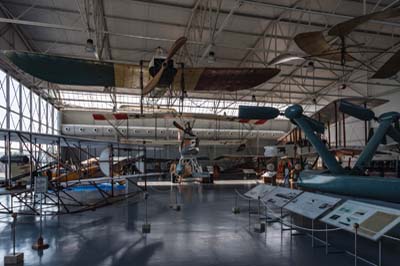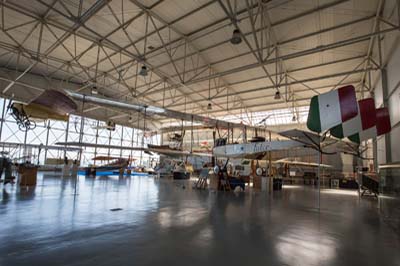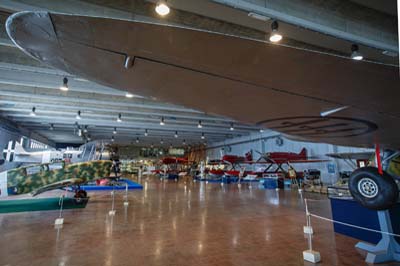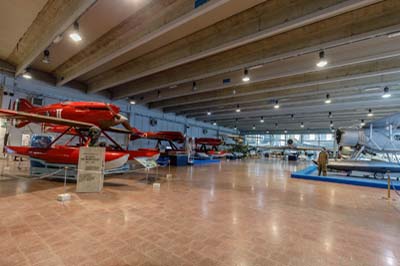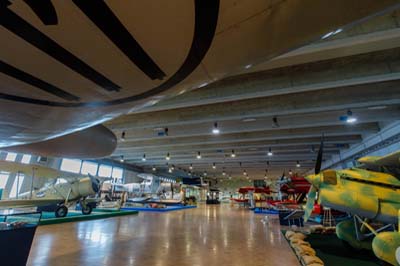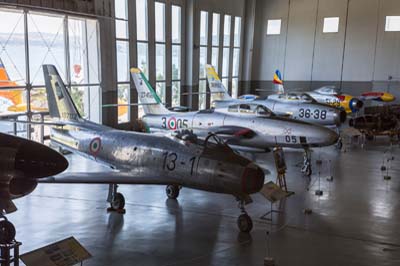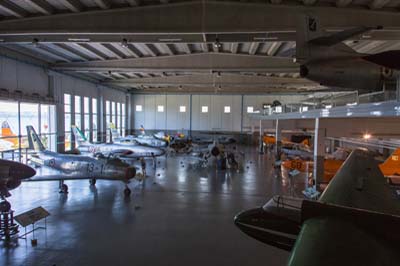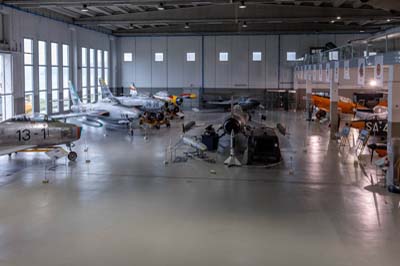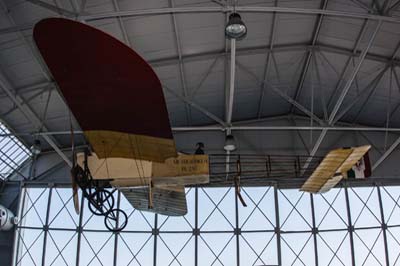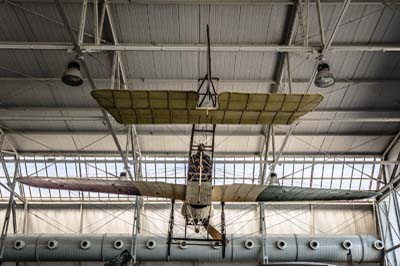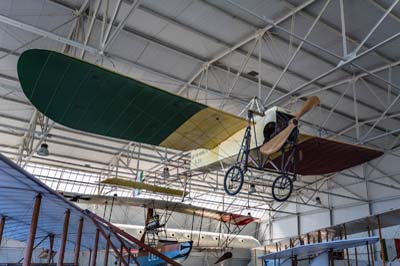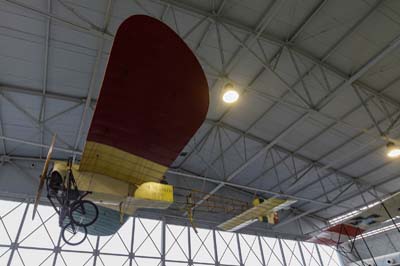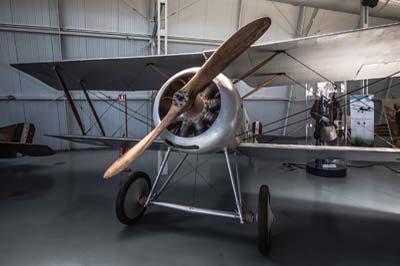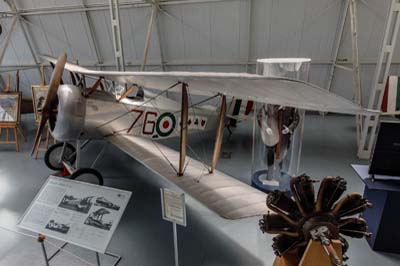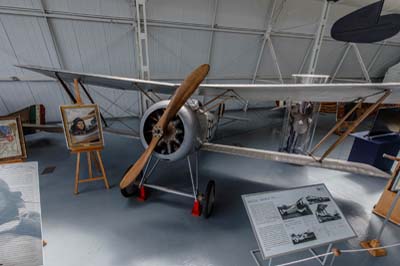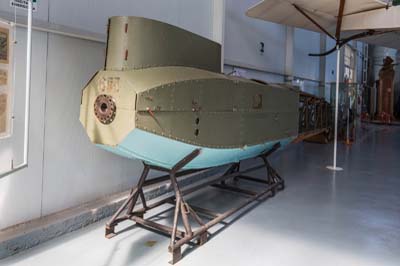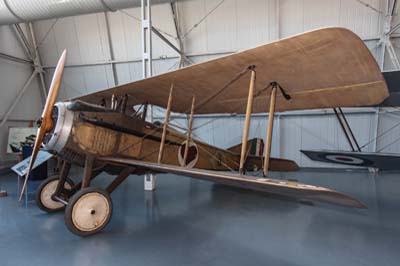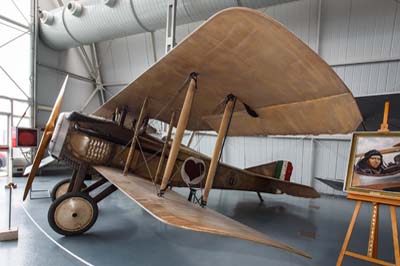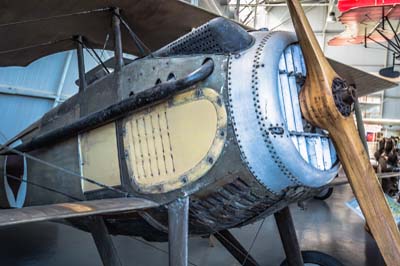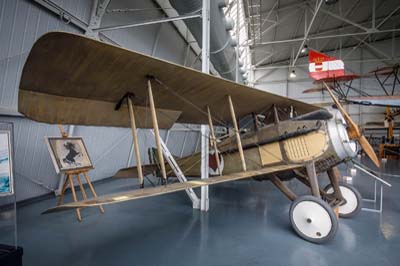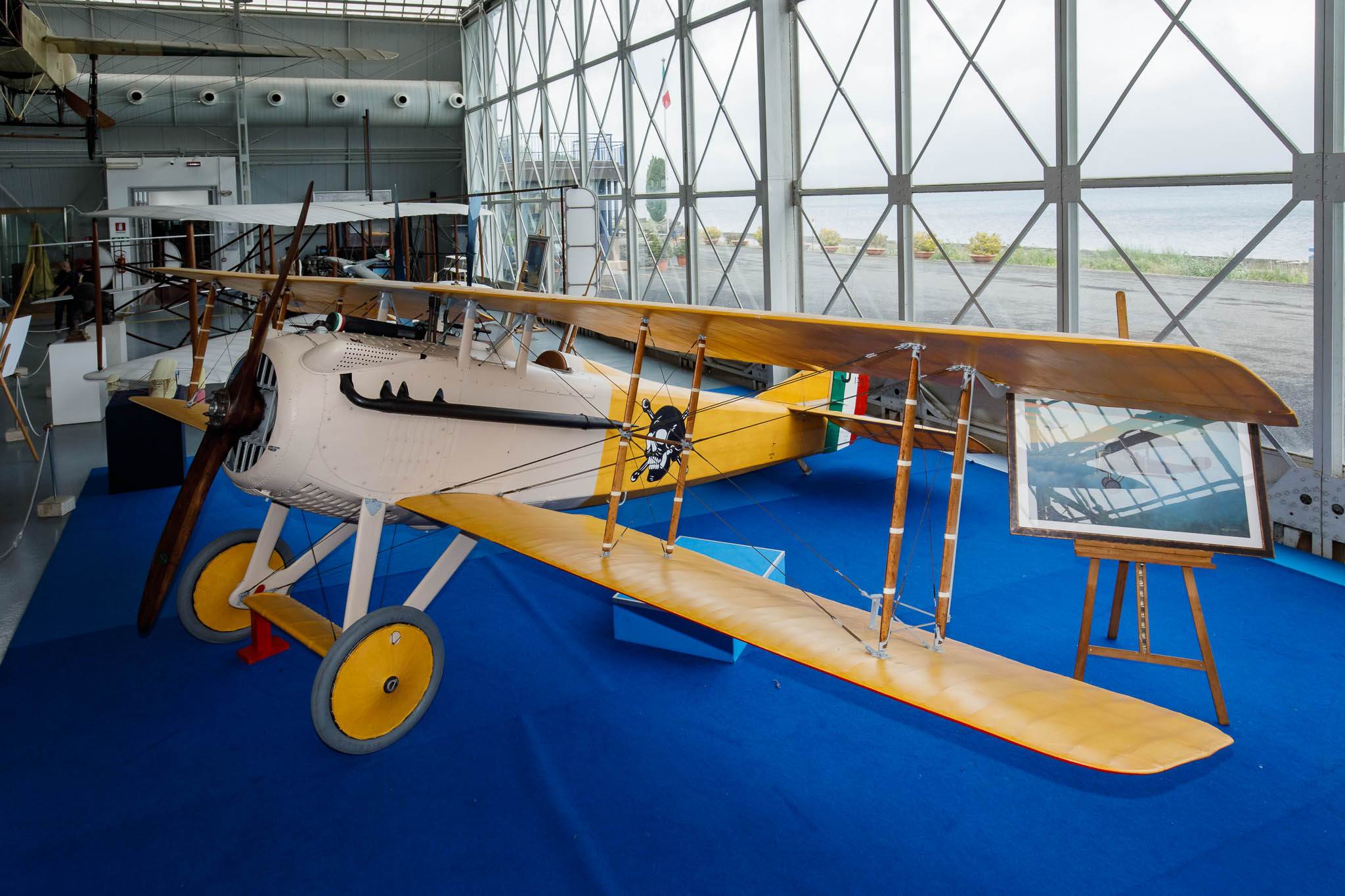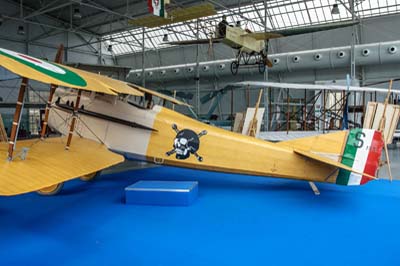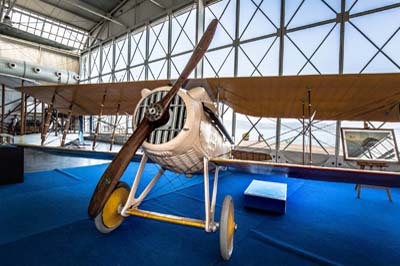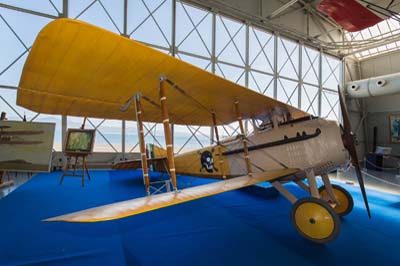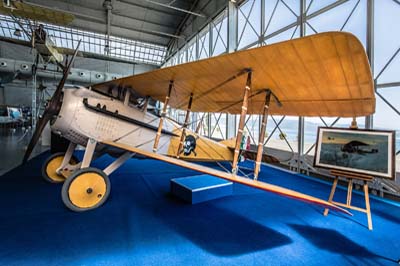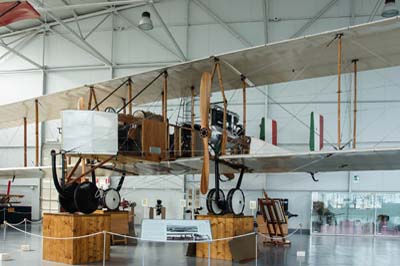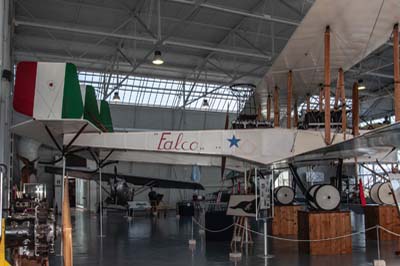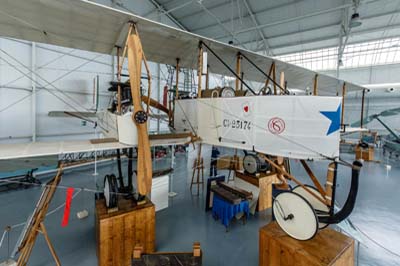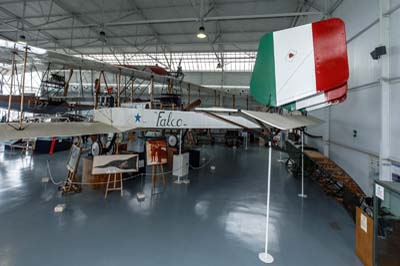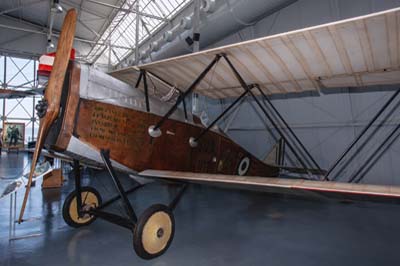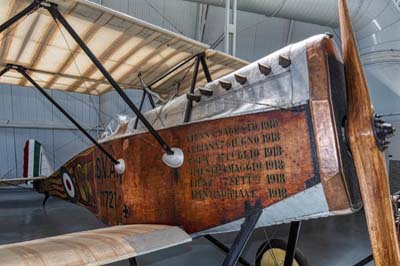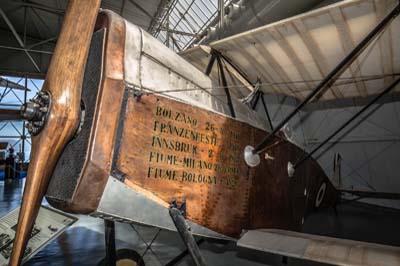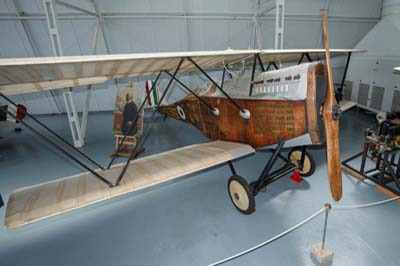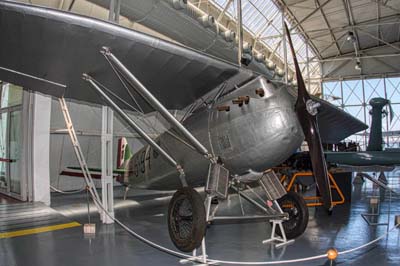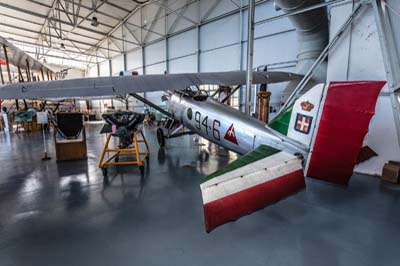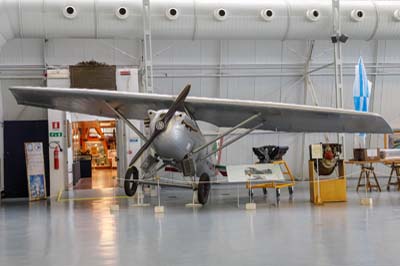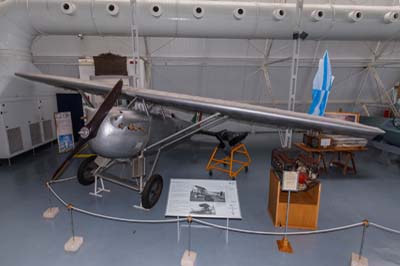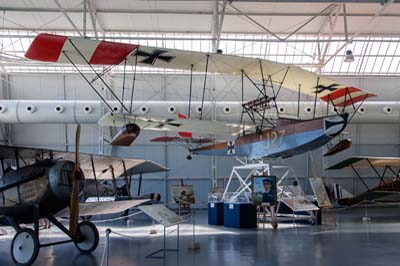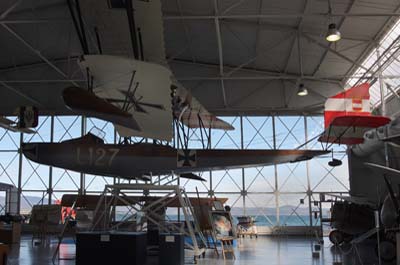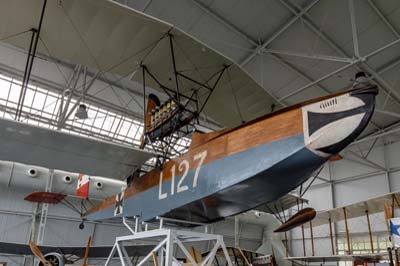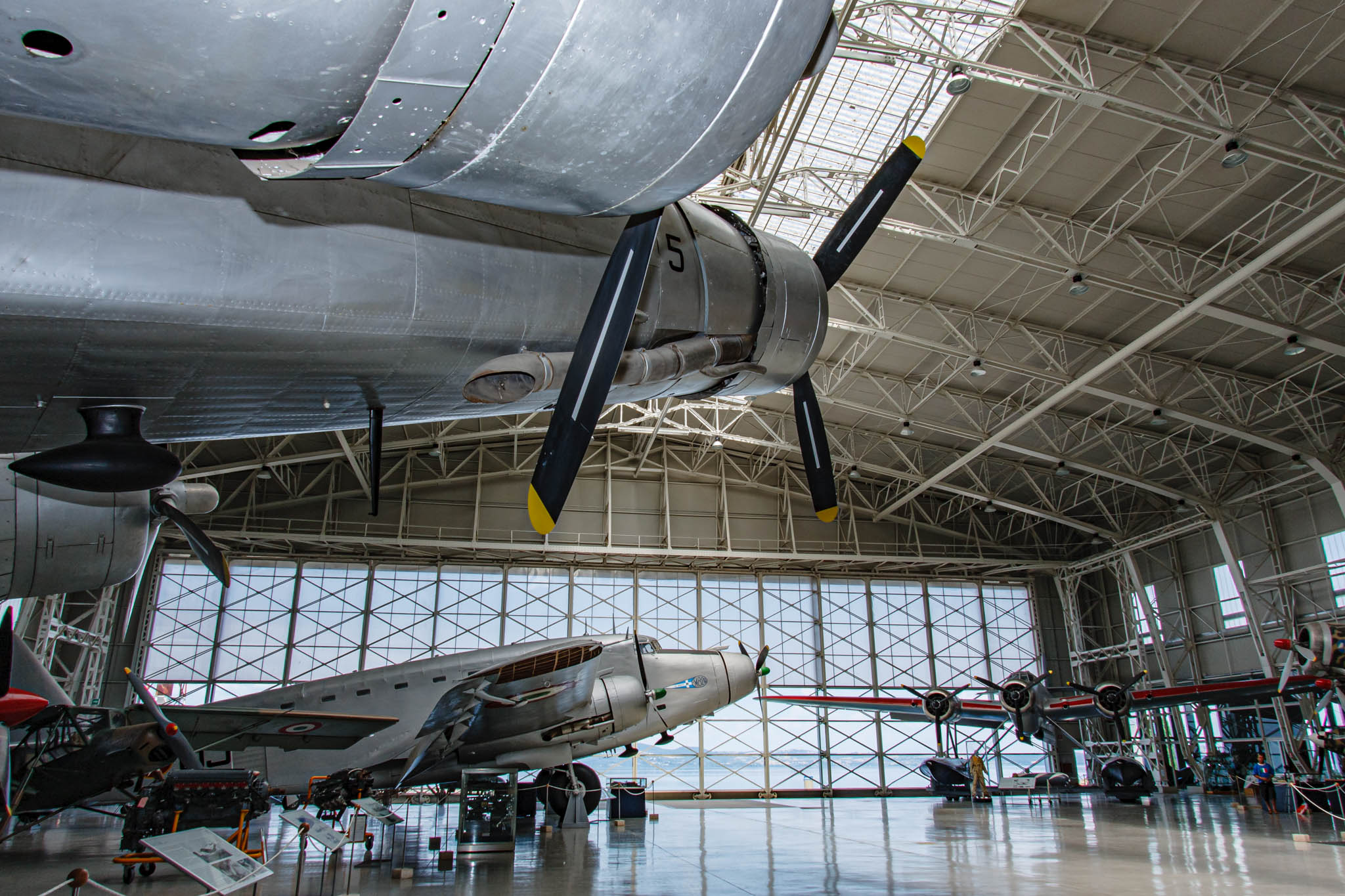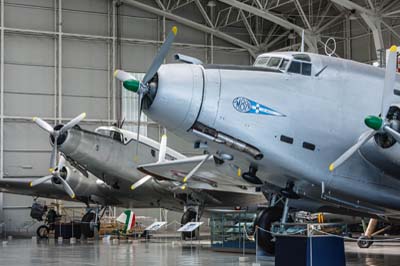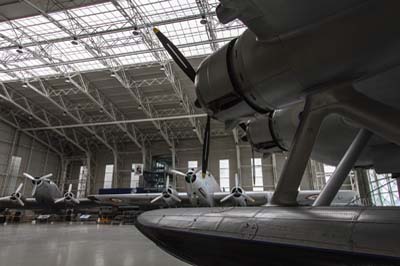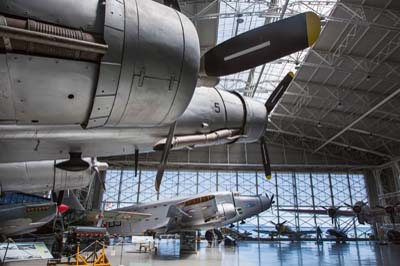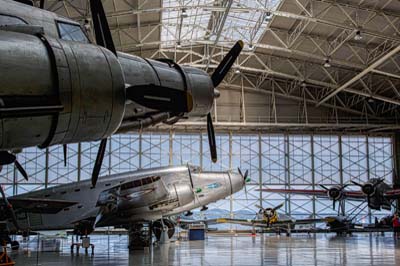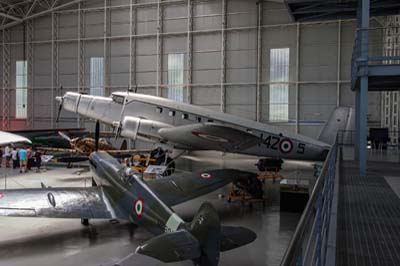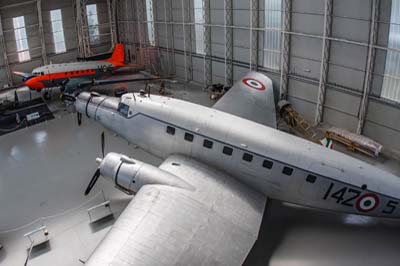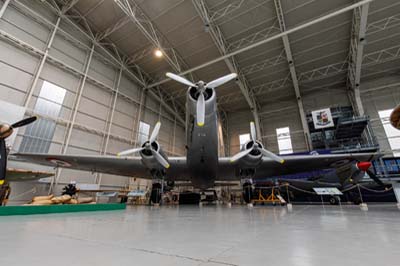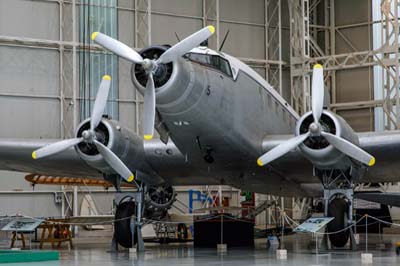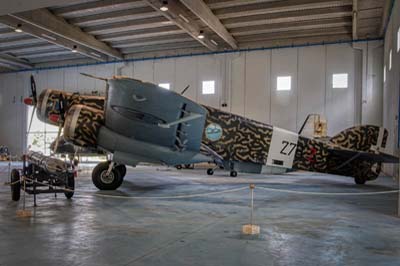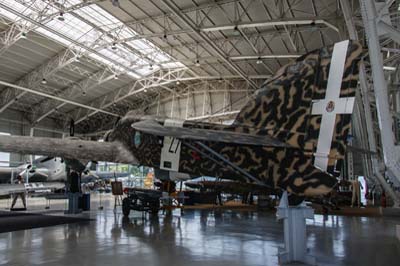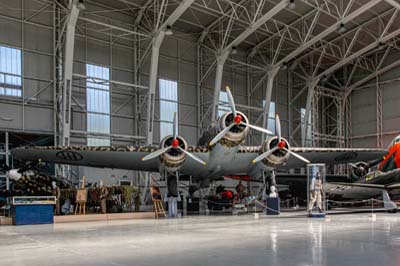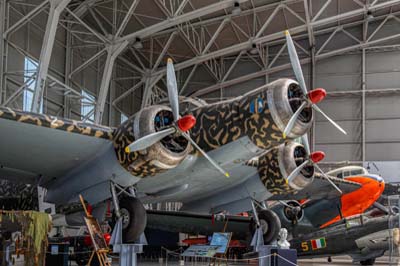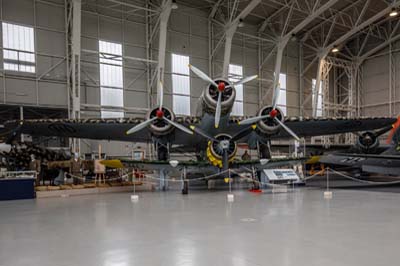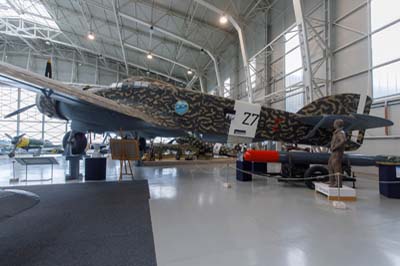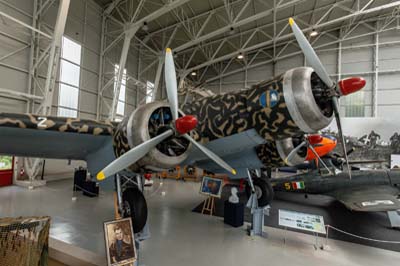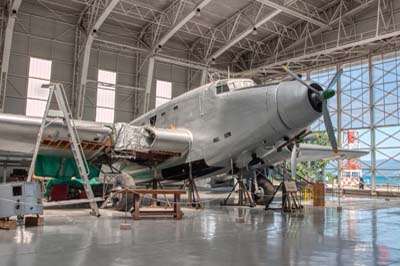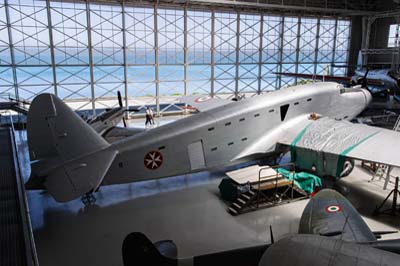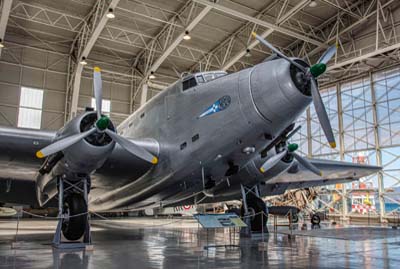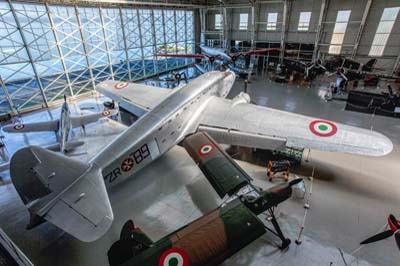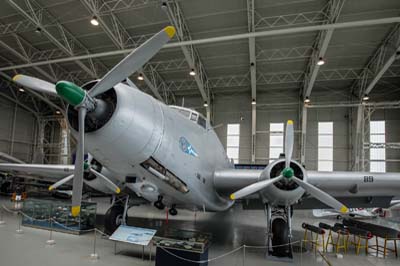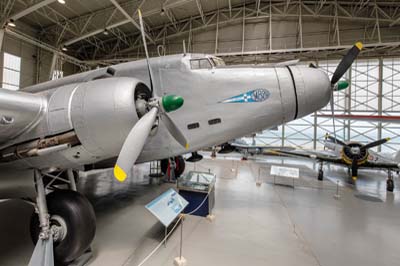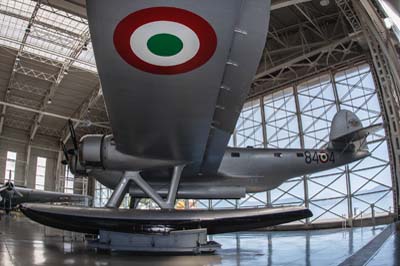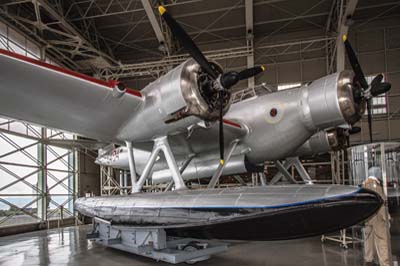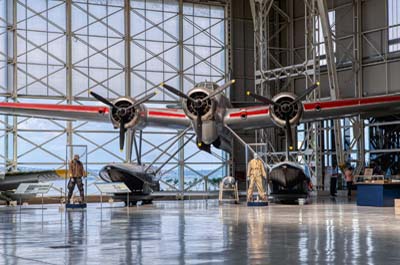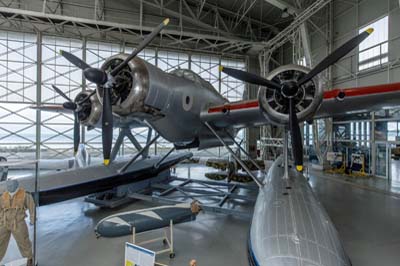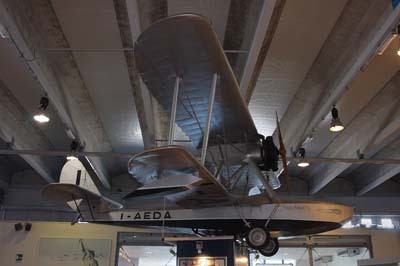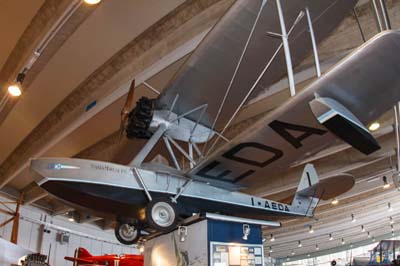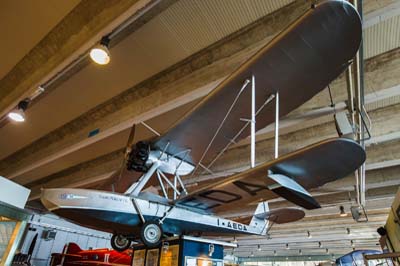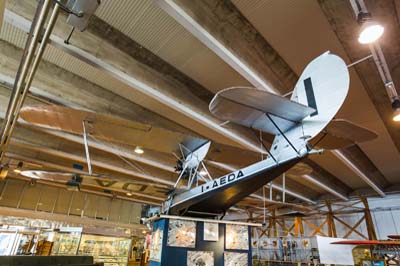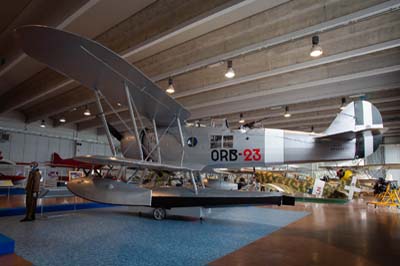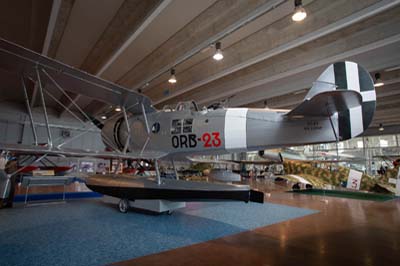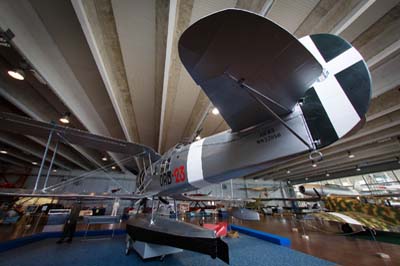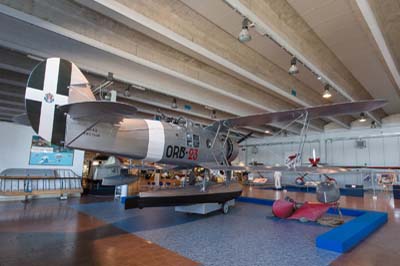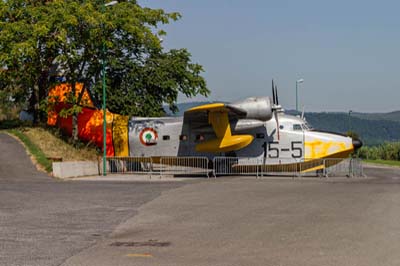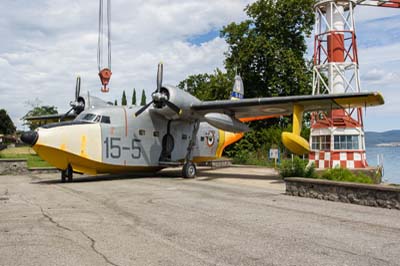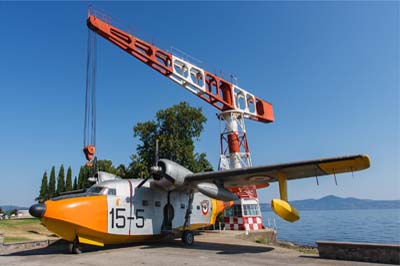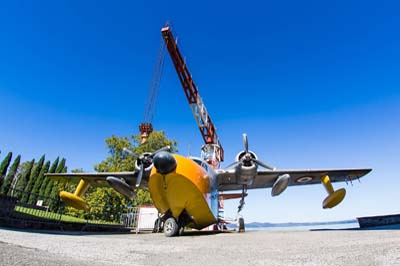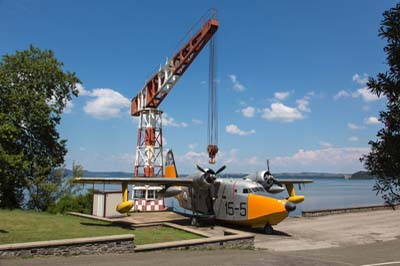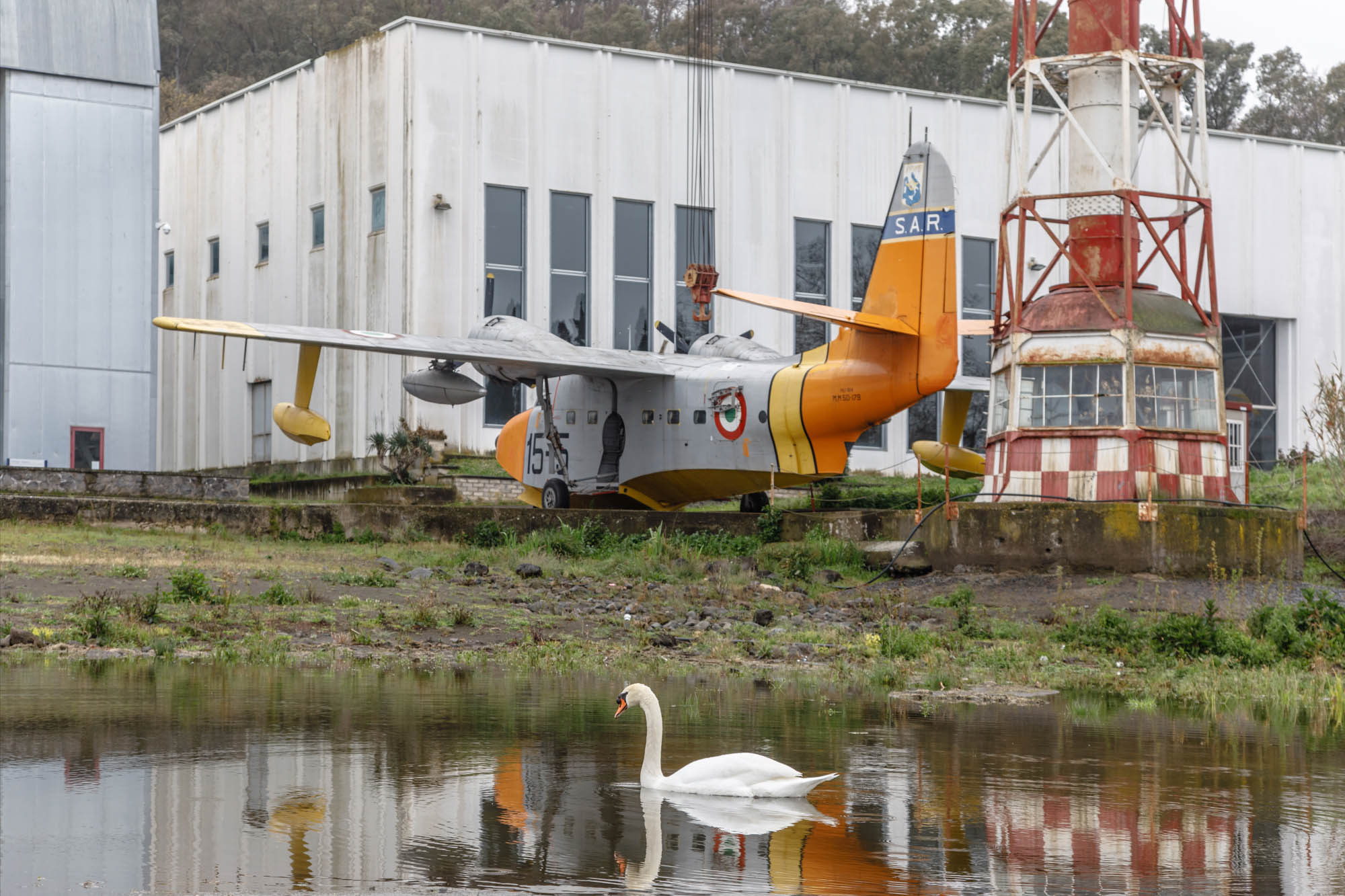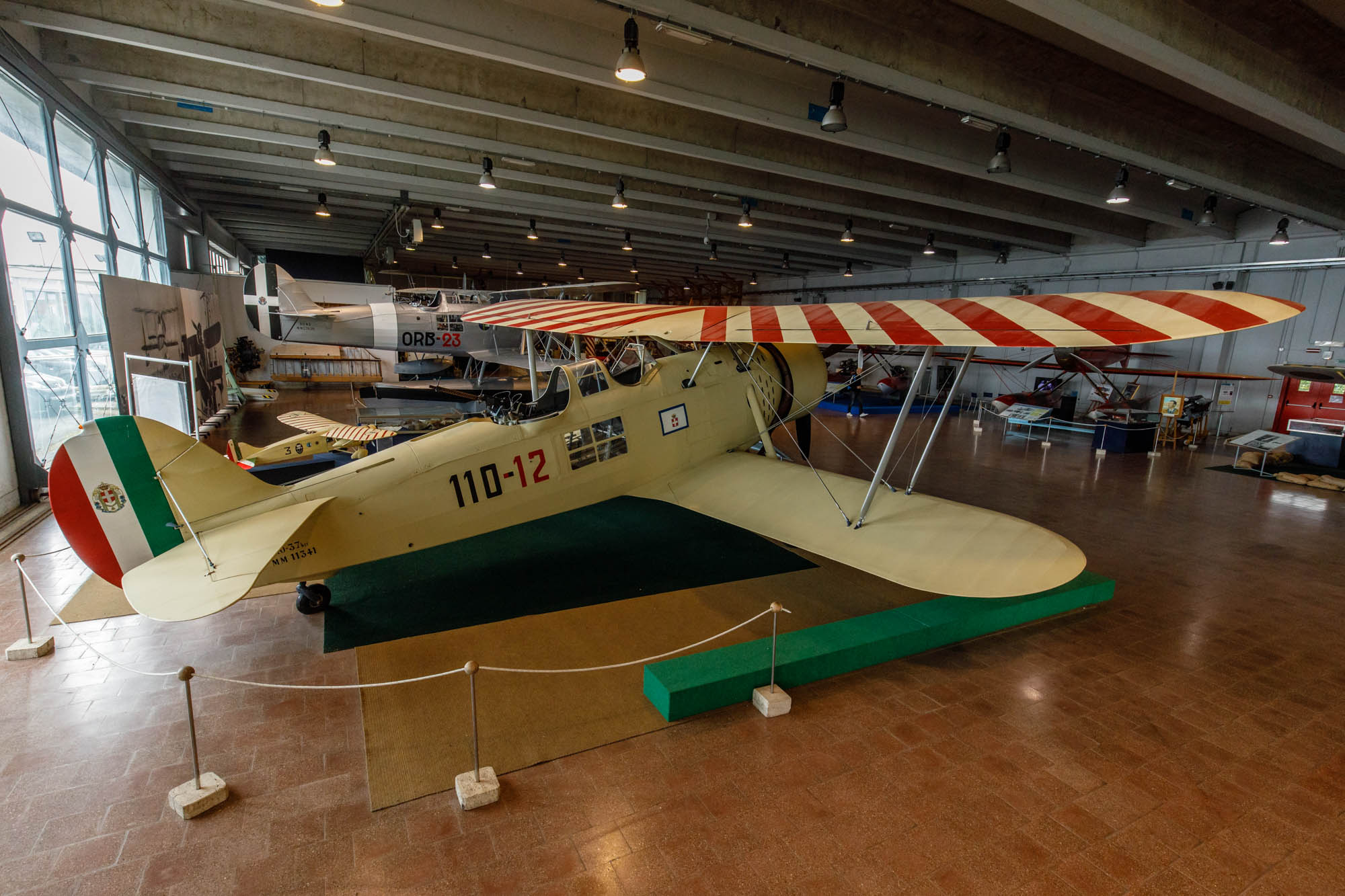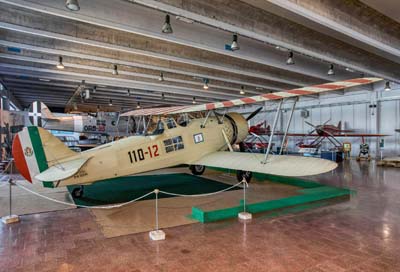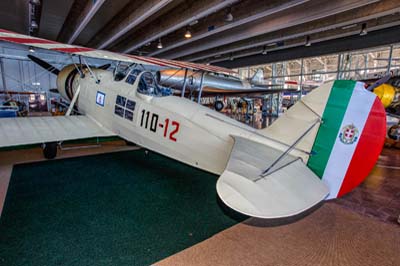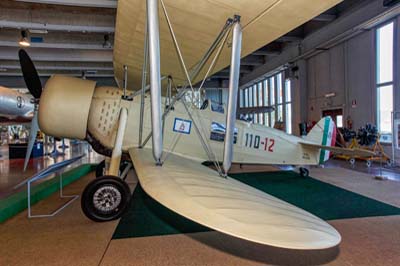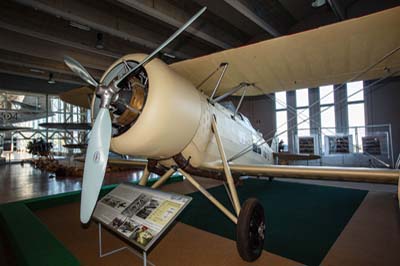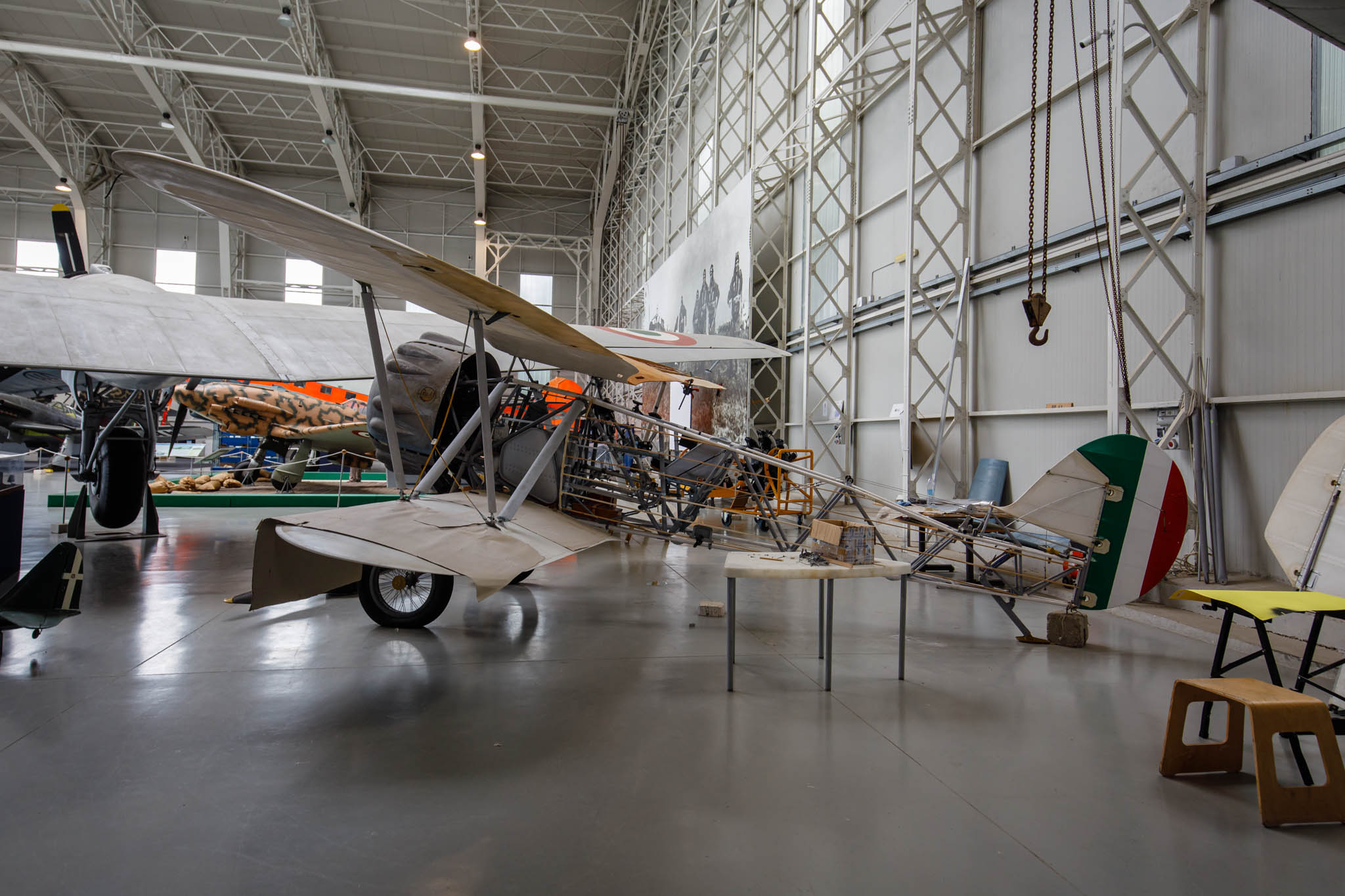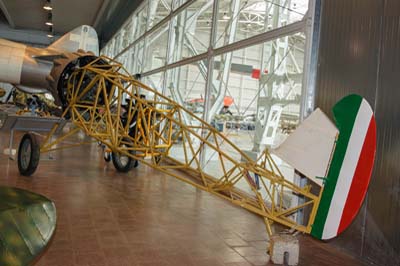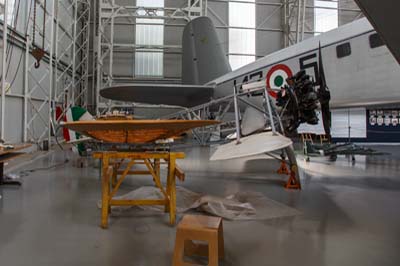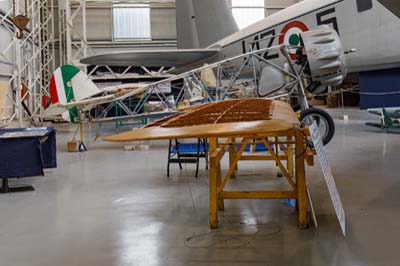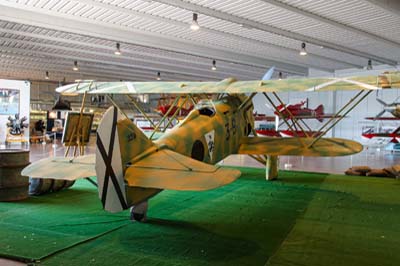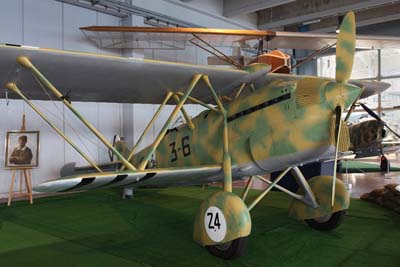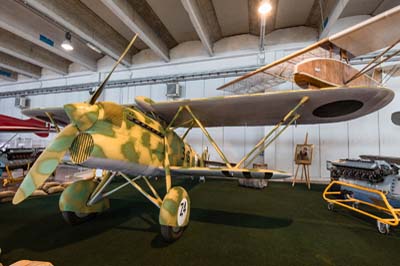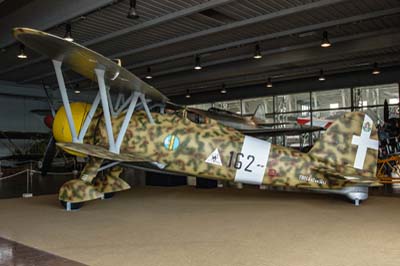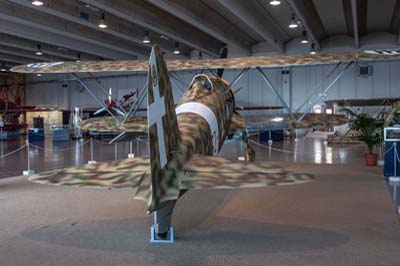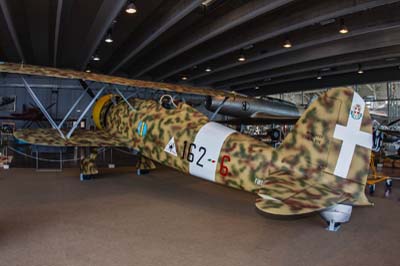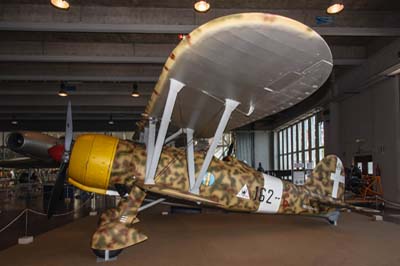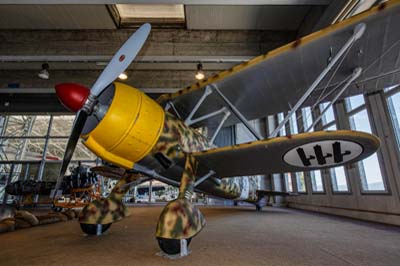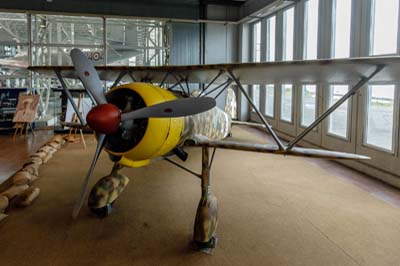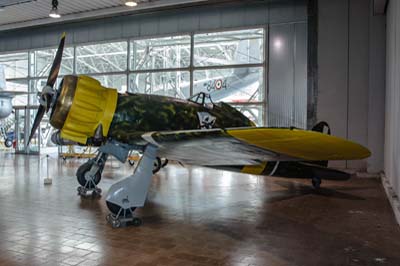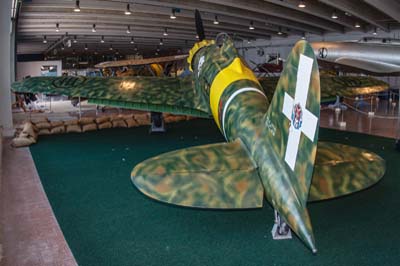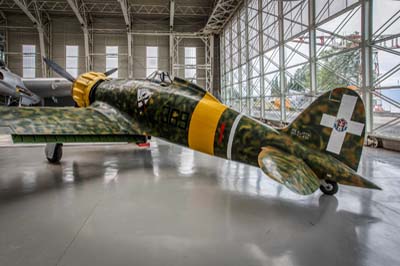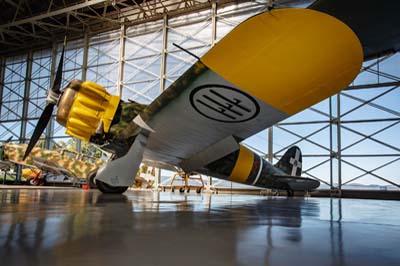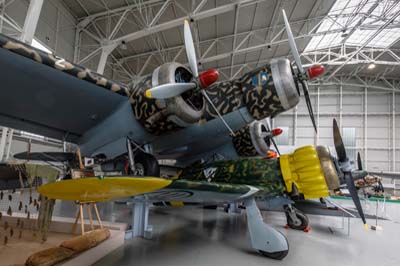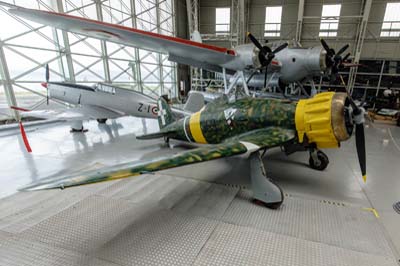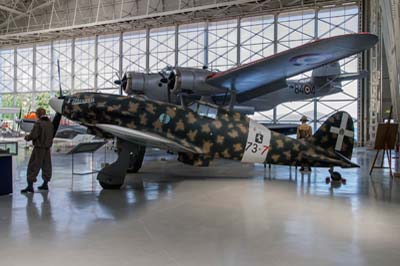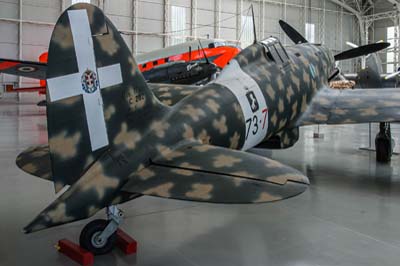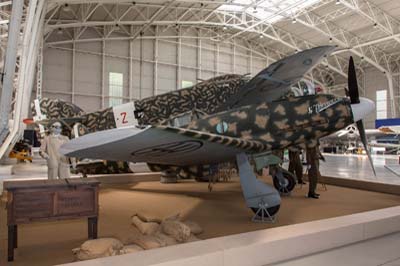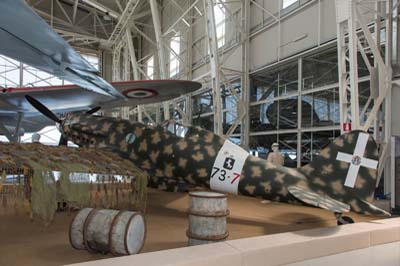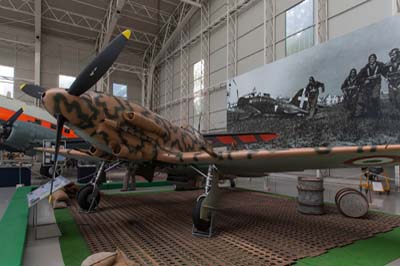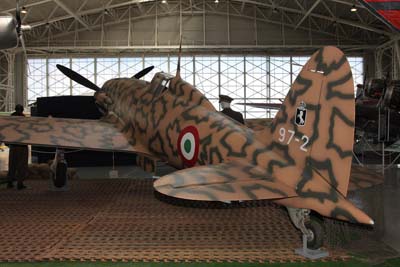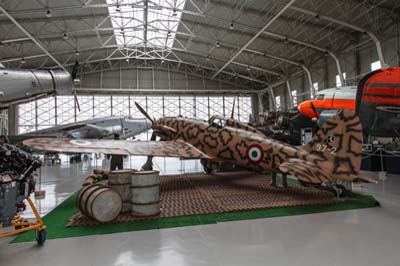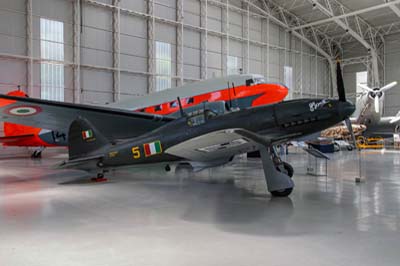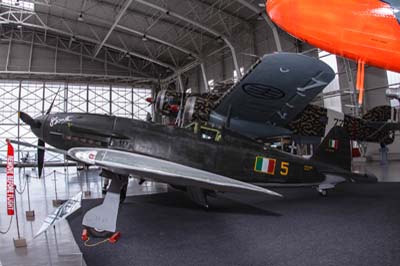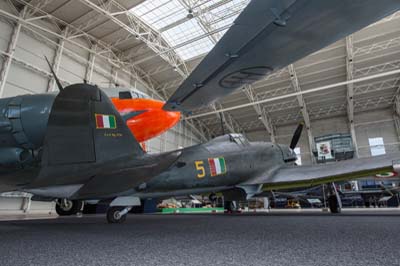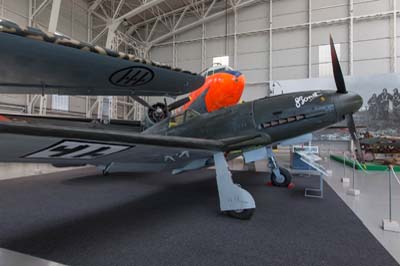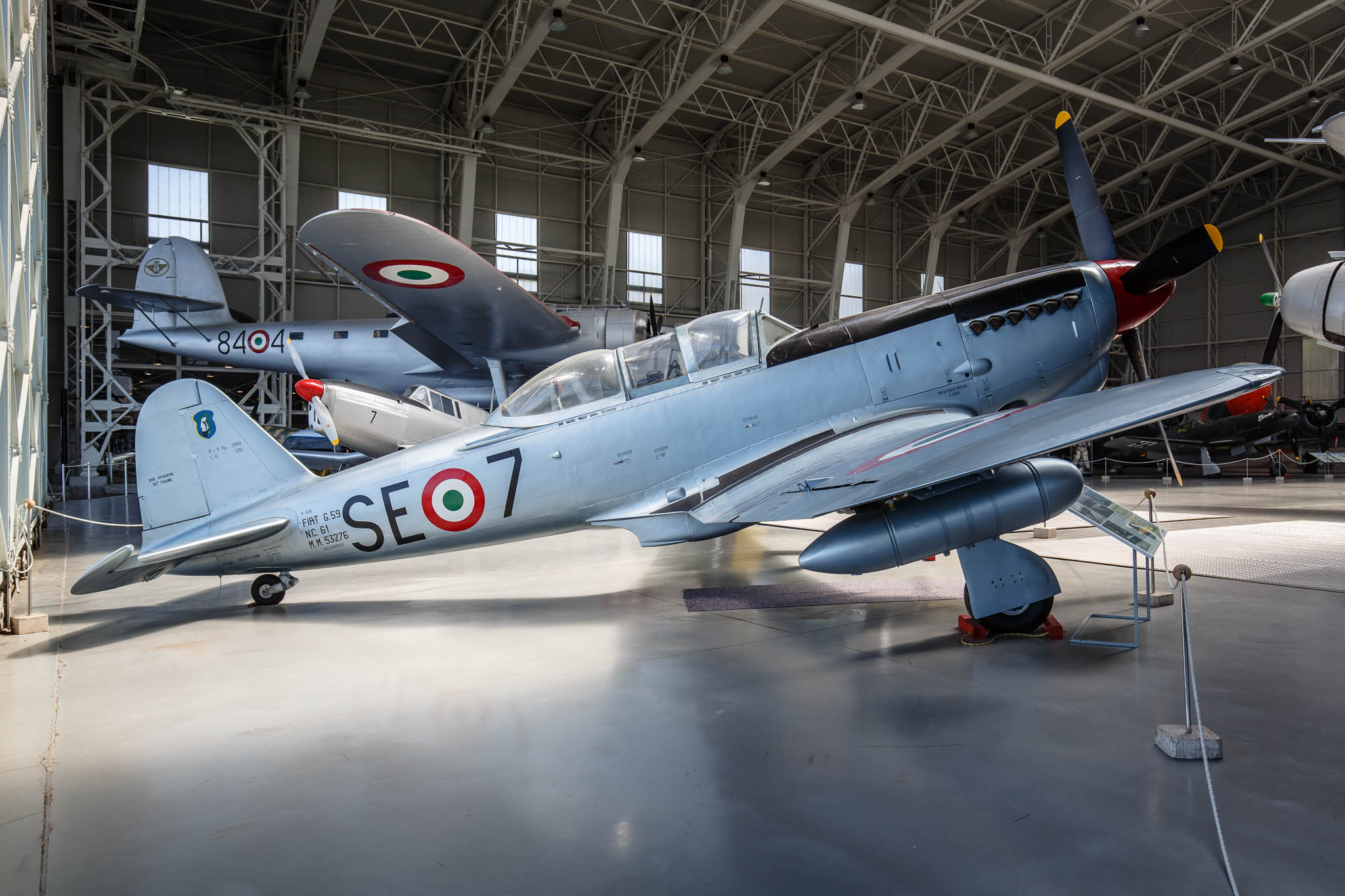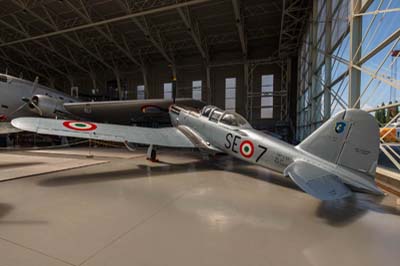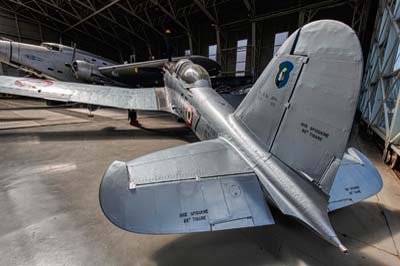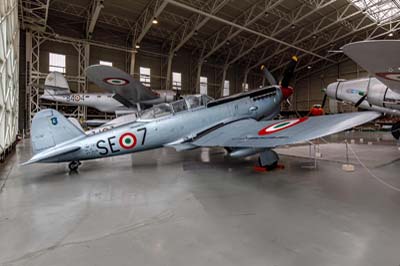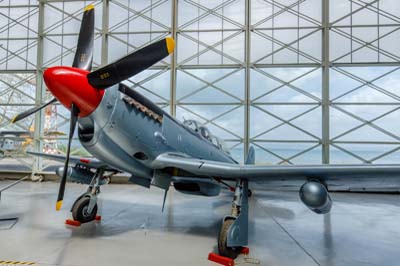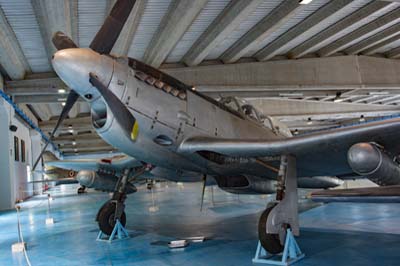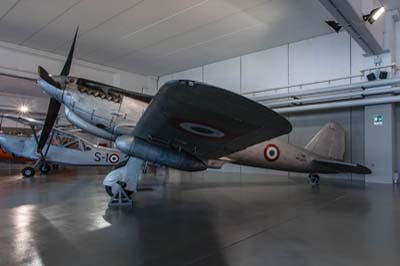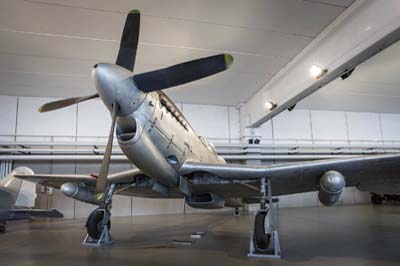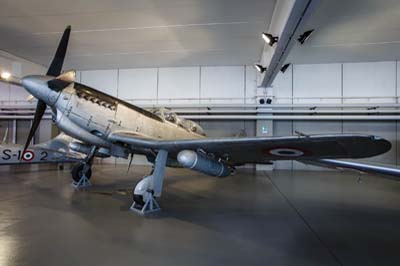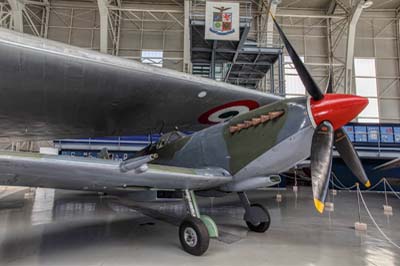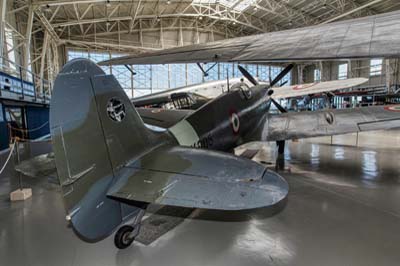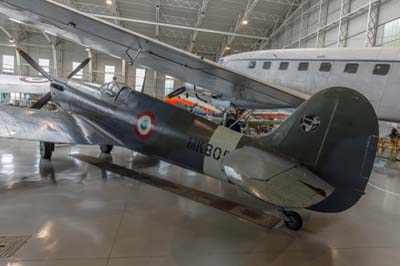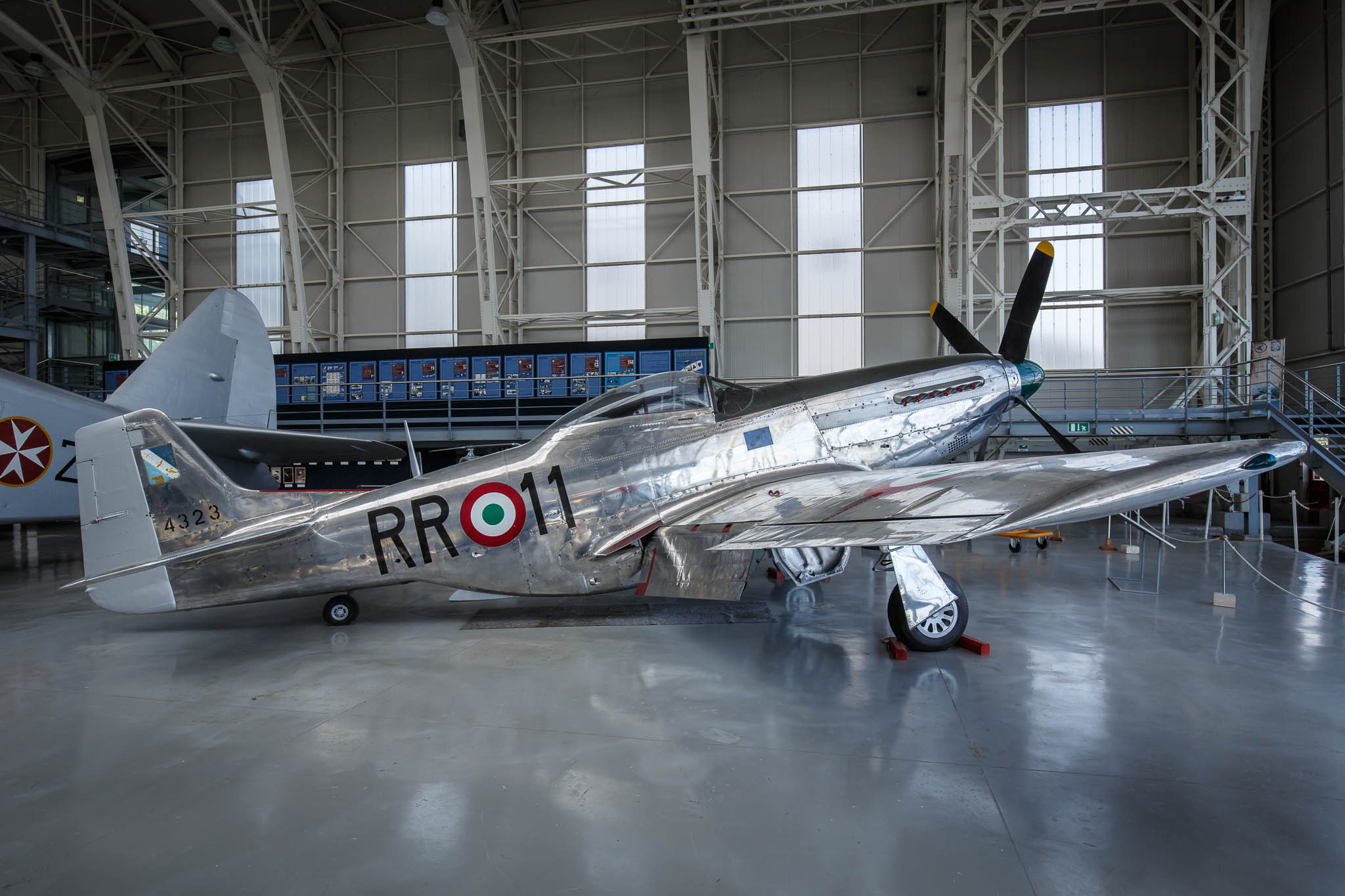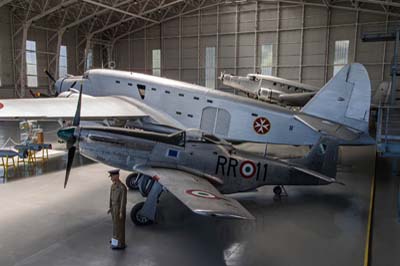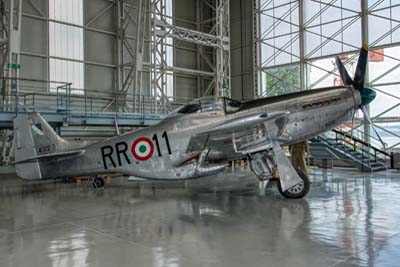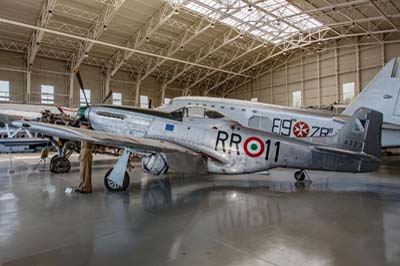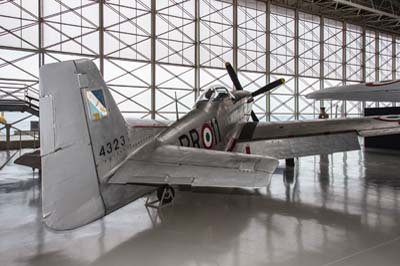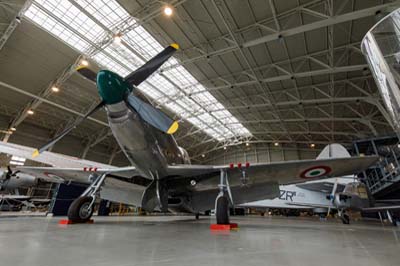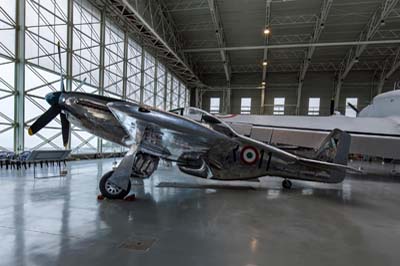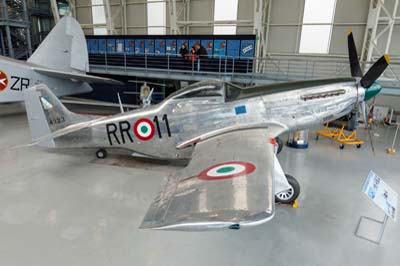The Italian Air Force Museum
(Museo Storico dell' Aeronautica Militare Italiana)
Vigna di Valle, Rome
2004, 2006, 2008, 2009, 2010, 2012, 2013, 2014, 2015, 2016, 2018 and 2019 |
A museum with a history
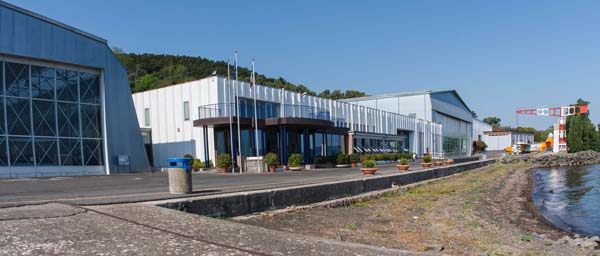
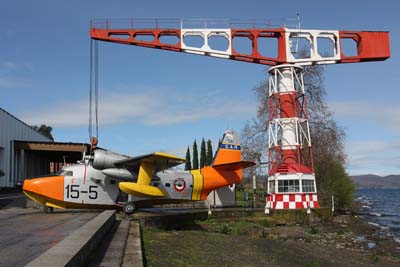 It was back in 1913 when Italy's first aeronautical museum was founded, at the Castel San Angelo in the centre of Rome. From 1933 the collection moved to other locations within Rome, tragically all the exhibits were lost during the World War Two. From the 1950s ideas for a new aeronautical museum began to develop. Finally in 1961 a museum in Turin was founded, unfortunately by 1974, the costs of running a large museum became prohibitive and it was closed.
It was back in 1913 when Italy's first aeronautical museum was founded, at the Castel San Angelo in the centre of Rome. From 1933 the collection moved to other locations within Rome, tragically all the exhibits were lost during the World War Two. From the 1950s ideas for a new aeronautical museum began to develop. Finally in 1961 a museum in Turin was founded, unfortunately by 1974, the costs of running a large museum became prohibitive and it was closed.
As the Italian Air Force (Aeronautica Militare Italiana - AMI) had buildings available at Vigna di Valle, the search for a cost effective solution was over. The current museum site, situated on the shores of Lake Bracciano and just 25km north of Rome, has an aeronautical history dating back to 1904. Italy's first airships and later its seaplanes were test flown from here.
On May 24, 1977 the Italian Air Force Museum, was opened by the Head of State at Vigna di Valle. At that time the museum consisted of two hangars or halls with an additional new connecting hall. |
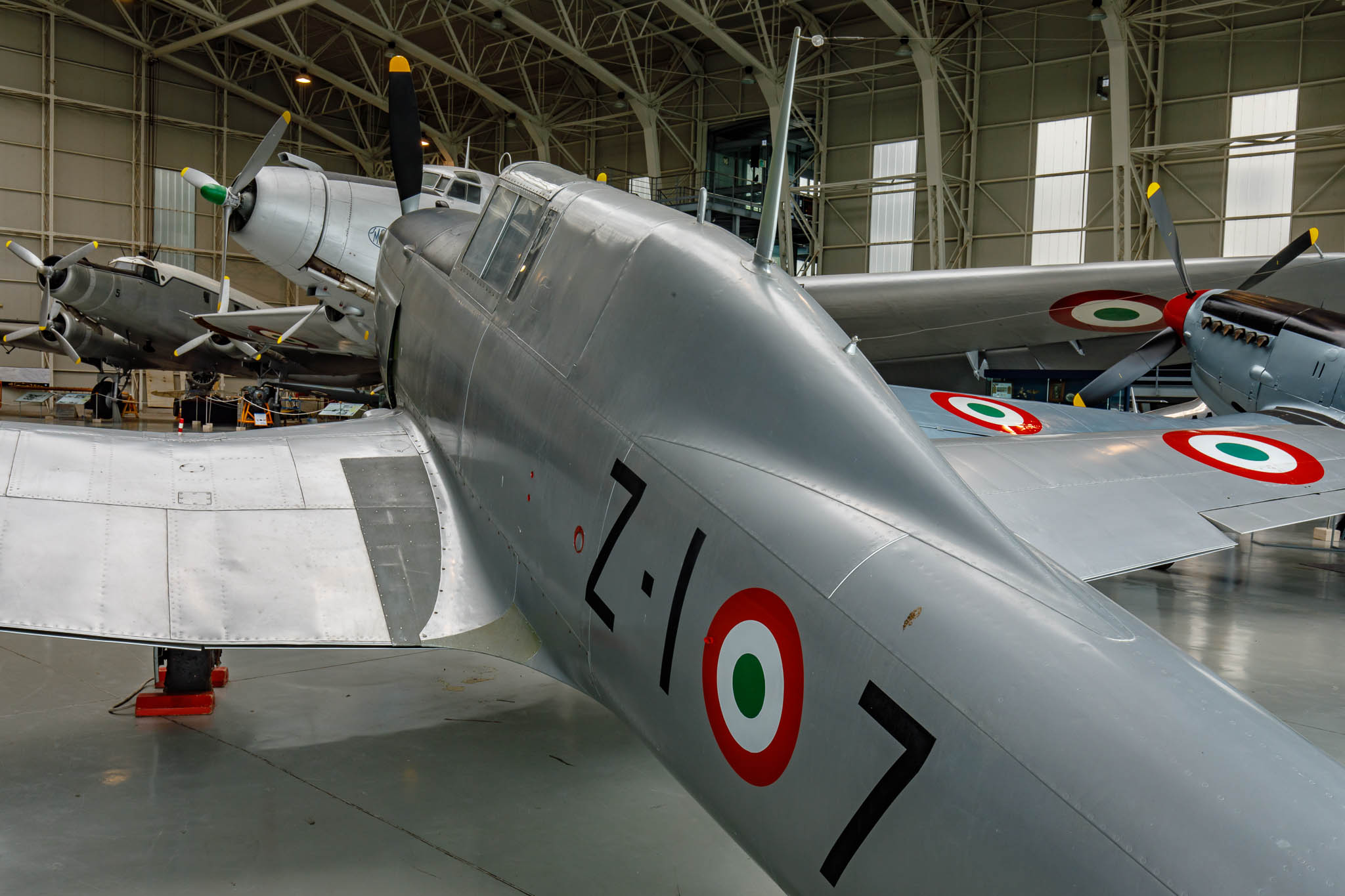 |
| The Italian Air Force Museum admirably and exclusively focusses on historic aircraft with an Italian background. Fiat G.46-4A (MM53286 'Z-17') in Hall 3 Badoni in April 2018. |
| The first hall called 'Troster' is of Austrian construction, built as reparation for destruction during World War One. Two hangars were originally built with wooden panels, these were replaced with metal sheets in 1925. The second of these two hangars was demolished in 1970. The remaining one is the oldest aeronautical building in Italy. 'Troster' hall houses the oldest aircraft in the collection, covering the period up to the end of World War One. One of the most interesting aircraft here is the Ansaldo SVA-5 which took part in the raid on Vienna in 1918. |
| In 1976 work started on a building to connect two original hangars, 'Troster' and 'Velo' to form both a modern entrance and an additional small hall. By May 1977 and just 200 days later the hall was completed in time for the grand opening. Velo hall houses an impressive collection of Italian seaplanes, designed to win the Schneider Cup for Italy. Also housed here some pre World War Two fighters and the unique Caproni Campini CC.1, which was one of the World's first jet aircraft. |
| Panoramic image of Hall 3 Badoni which was built in 1930. July 2012. |
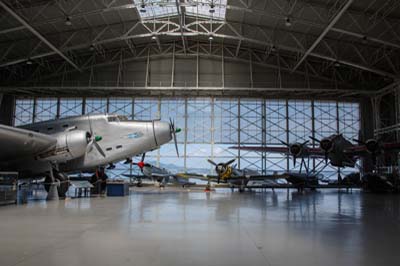
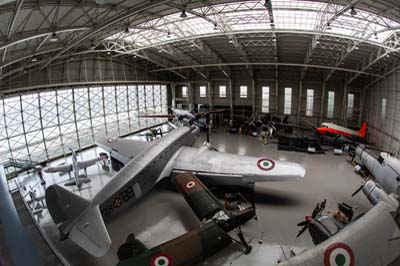 Badoni hall was originally constructed in 1930 by the Badoni company, for the maintenance of Italy's largest seaplanes. It was used by 84º Gruppo who were flying the CRDA Cant Z.506, a three engine seaplane until 1959. 84º Gruppo converted to the Grumman HU-16 Albatross at Rome Ciampino. By 2004, the wonderful historic Badoni hangar, which had been closed for some time for roof repairs and modification, was reopened.
Badoni hall was originally constructed in 1930 by the Badoni company, for the maintenance of Italy's largest seaplanes. It was used by 84º Gruppo who were flying the CRDA Cant Z.506, a three engine seaplane until 1959. 84º Gruppo converted to the Grumman HU-16 Albatross at Rome Ciampino. By 2004, the wonderful historic Badoni hangar, which had been closed for some time for roof repairs and modification, was reopened.
During a visit the museum Director Lt Col Massimo Mondini, invited me to see the progress being made in here. The impressive Fiat G.212 'Flying Classroom', sat there lonely and forlorn in the dark, with dust and debris all around. Lt Col Mondini who took great pride in the work done here, wanted to emphasise that the museum's valued exhibits were safe and not in decay, as had been reported in the press earlier that year.
Following extensive construction work, the original hangar doors had large full height glass windows fitted. This made it much brighter and better for natural light photography. New elevated walkways provide a better perspective, and now connect this hall to the Skema hall next door. A large red and white static crane, used to lower the seaplanes into the water, is still in place outside beside the lake with a HU-16 positioned underneath. |
In 1978 a plan was put forward to construct a fourth hall to house the expanding collection of aircraft. Finally in 1986 work started on the massive concrete slab construction, known as Skema Hall. By 1993 the hall was ready to house around 25 aircraft on two levels, from Italy's first jets to the more modern. Whilst this hall is very large and essential, if the collection is to be protected from the elements, pretty it is not. Sadly it is not in keeping with its surrounding historic buildings. By 2004 all four halls were connected and having a combined floor area of over 39,300 Square Feet (12,000 Sq m). The exhibits are displayed in chronological order from the oldest aircraft in the historic Troster hall, through to the more modern jet aircraft in Skema hall.
By March 2008 full length windows had been added to the front of the hall, providing considerably more natural light in and is a welcome improvement, click before and after. An annex or pavilion to the front of the hall was partly constructed in 2008 and formally opened on June 18, 2009. |
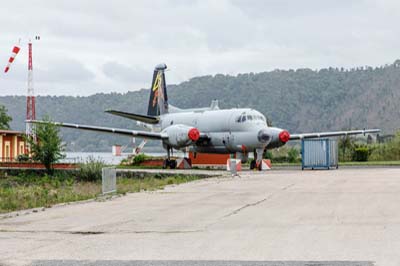 |
Bréguet 1150 Atlantic (MM40118 '41-03') was retired on November 22, 2017 with a final flight from Sigonella, home of the 41° Stormo the final AMI unit to operate the Atlantic. It arrived on October 18, 2018 it was airlifted in sections by S-64 Skycrane. It is actually being held on the military side of the base, 100 meters away from the public grounds of the museum. |
The Aircraft Collection
Most years since the opening of the museum in 1977, I have made a pilgrimage to Italy's finest aircraft museum. So what has happened to the collection on display over the years?
In the 1980s a grass area by the lower car park, was used to display numerous aircraft. Unfortunately with Italy's scorching sun, paint work quickly faded and these exhibits started to look a little shabby. Since then, much of the collection has been rationalised. By the early 1990s the aircraft on display in the three halls then available, had risen to around 70 airframes. In the 1990s various construction works principally on Skema hall, meant that all or part of the collection was not available for viewing.
These days less than 70 aircraft can be seen in four halls. Duplicate or similar variants of aircraft have been put into store at Guidonia, Pratica de Mare and perhaps other places. Prior to 1991, there was a Fiat G-80 with two of the later G-82s on display outside, all in a sorry looking state. Now just the more recently restored G-80 remains and is displayed upstairs in Skema hall. The G-82s have gone back to Pratica di Mare from where they were originally test flown. There is now more space between the exhibits, which is better for photography, since the jets were moved from hall 3 to new Skema hall in the mid 1990s. By March 2008 there were just two aircraft on display outside, an HU-16 Albatross and a PD-808.
It is noticeable that all the jets here currently on show, flew with the Italian Air Force, most were assembled in Italy, if not designed and built in the country. The collection once displayed a SAAB J29F Tunnan which had been abandoned by the Swedish Air Force, following mechanical failure during an exercise. As this aircraft has no connection to the Italian Air Force, the Museum to their credit, put it in storage.
This is now the beauty of the Museo Storico, it presents Italian aviation heritage. Famous Italian aircraft manufacturers such as; Agusta, Caproni, Fiat, IMAM, Macchi, Piaggio and Savoia-Marchetti have numerous types represented here. Too many museums succumb to the temptation, to swap or buy Eastern European MiGs or whatever, which have in recent years flooded the museum 'market', thinking that they enhance the collection's appeal, in my opinion they do not.
Well, what does the museum have on offer to the aviation photographer, enthusiast and historian? Something for everyone is my answer. I will now detail most if not all of the museum's interesting exhibits.
|
The beginning of flight
The oldest aircraft here are some of the most interesting, especially when you look into their past. |
| Blériot-SIT XI-2 (BL246). Designed by the French aviator Louis Blériot in 1909. The French, British and Italian air forces took delivery of 132 Blériot XI's from 1910. The Blériot was the first aircraft to be used during war when it was flown by the Italian Air Force in 1911 during the Italy-Turkey war of 1911 and later in the Libyan war of 1912. The aircraft on display is inscribed 'XIII Squadriglia BL 246'. |
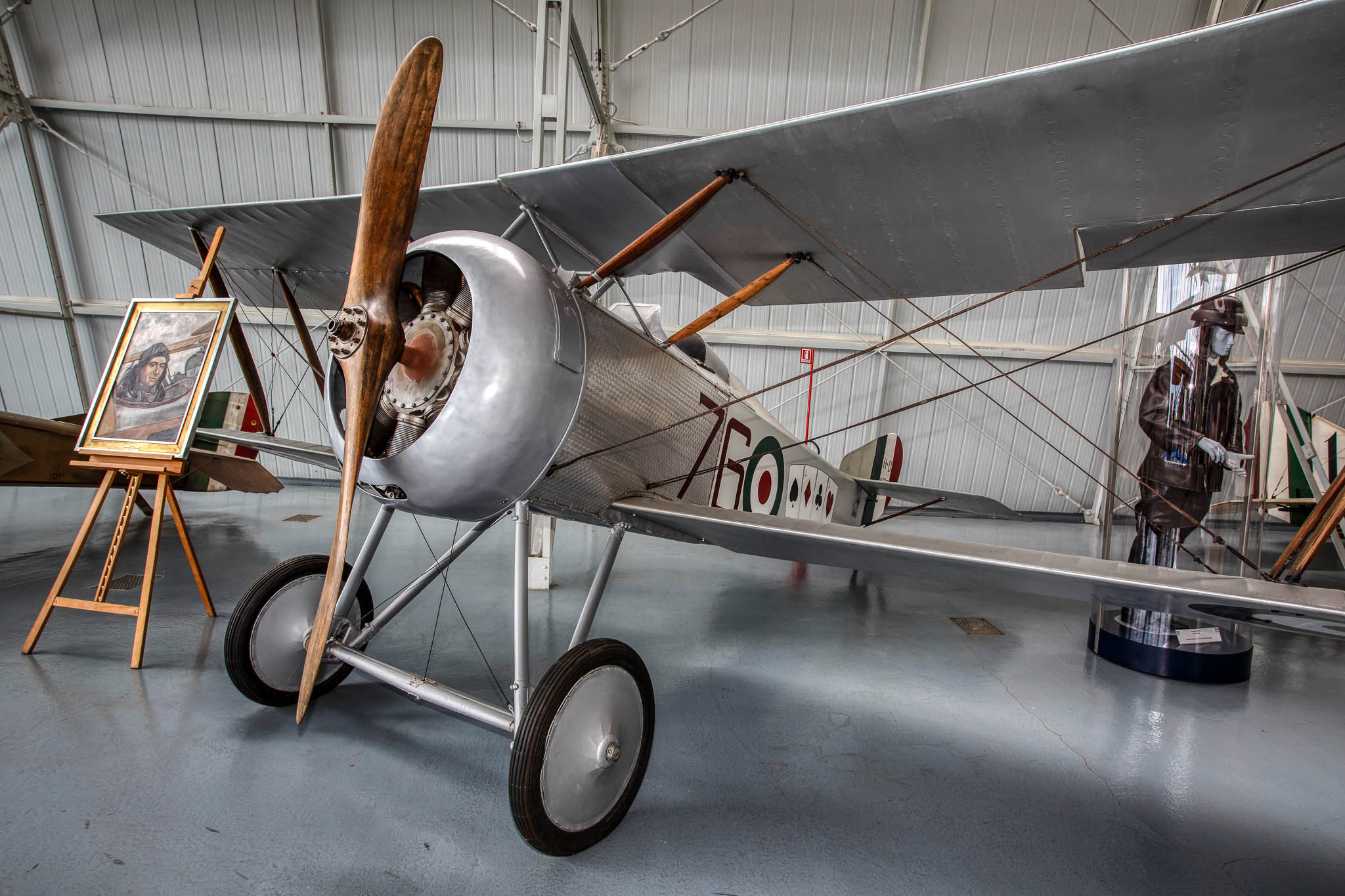 |
Macchi Hanriot HD.1 (unknown serial, coded '76'). This is a French designed World War One single seat fighter which was supplied to the Belgian and Italian air forces, the French chose the SPAD S.VII instead. Around 1,200 were delivered of which 831 were built in Italy by Nieuport-Macchi of Varese under license between 1917 and 1919. By November 1918 16 of the 18 Italian fighter squadrons were equipped with the aircraft. After the war a number of these aircraft were passed to the Swiss Air Force.
The example on display was flown fighter ace Lieutenant Flavio Torello Baracchini who was credited with 21 confirmed and nine unconfirmed aerial victories, ranking fourth of all World War One Italian aces.
Junkers J.4 The Junkers J.1 first flew in 1917 and was the first all-metal aircraft to be mass produced (227 built), it entered service in 1918. It is a two-seater and was used for reconnaissance and close air support of troops.
The fuselage on display is described as a 'spoil of war', it was previously on display at the Science and Technology National Museum in Milan. The only other surviving Junkers J.1/J.4 is at the Canada Aviation and Space Museum in Ottawa, it has construction number 252. |
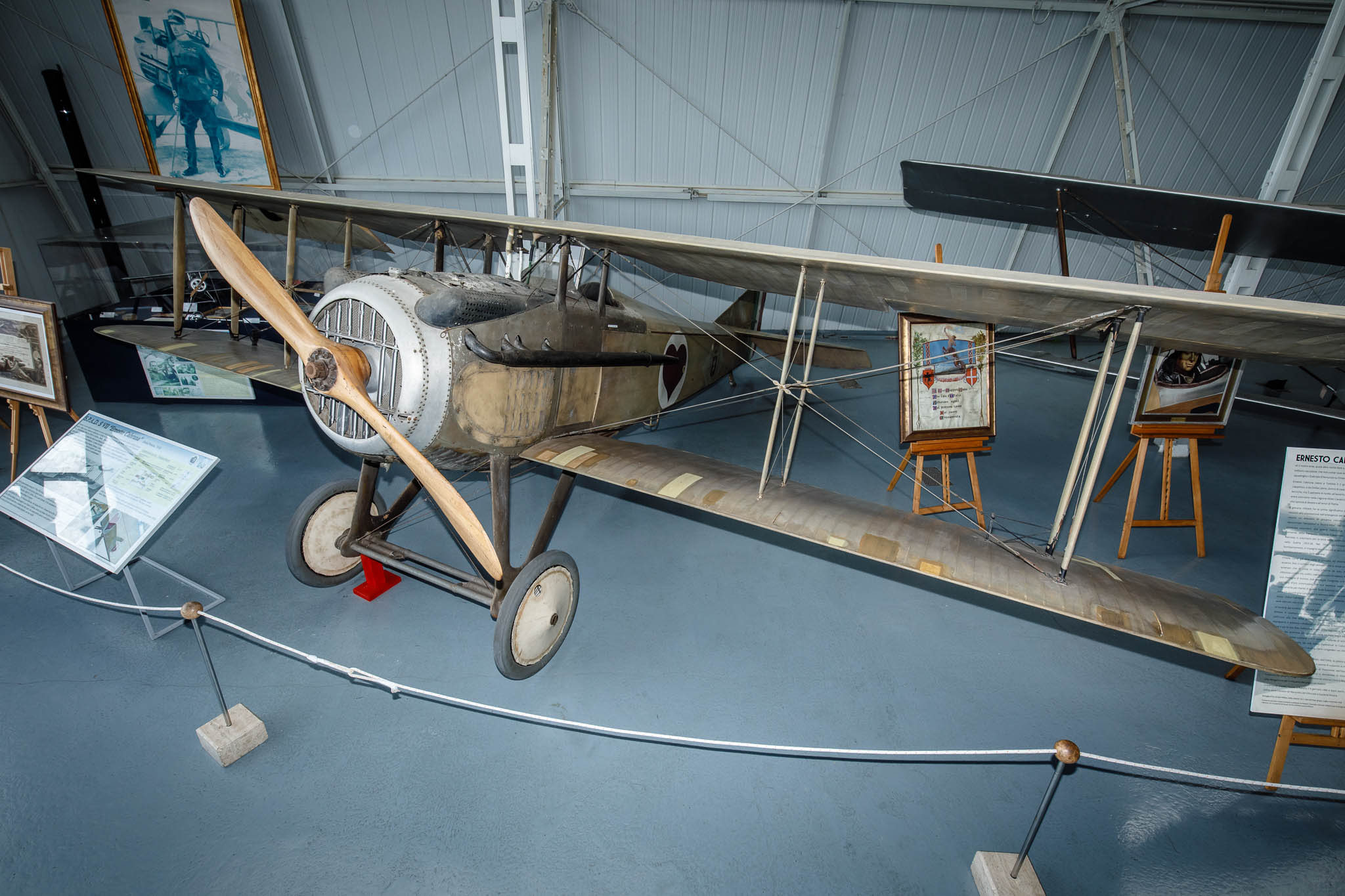 |
SPAD S.VII which was piloted by 'ace' Ernesto Caburna it still shows where numerous bullet holes were stitched up after encounters with the enemy.
Many SPAD S.VIIs were built during World War One for the Italian, British, French, Belgian, Russian and United States air forces. |
| SPAD S.VII (S.153) was presented to 'ace' Fulco Ruffo di Calabria after he had scored 20 victories in 1919. Ruffo later presented the aircraft to the Air Force Academy in the 1930s. Ruffo succeeded Francesco Baracca as Commander of the 91st Squadron. During restoration in 2001 by GAVS in Rome it was discovered that this aircraft was built in September 1916, making it the oldest in existence. It has Ruffo's 'skull and cross bones' insignia on the side. A replica SPAD S.VIII ('S.1420') was on display here from 1980 till 2004. |
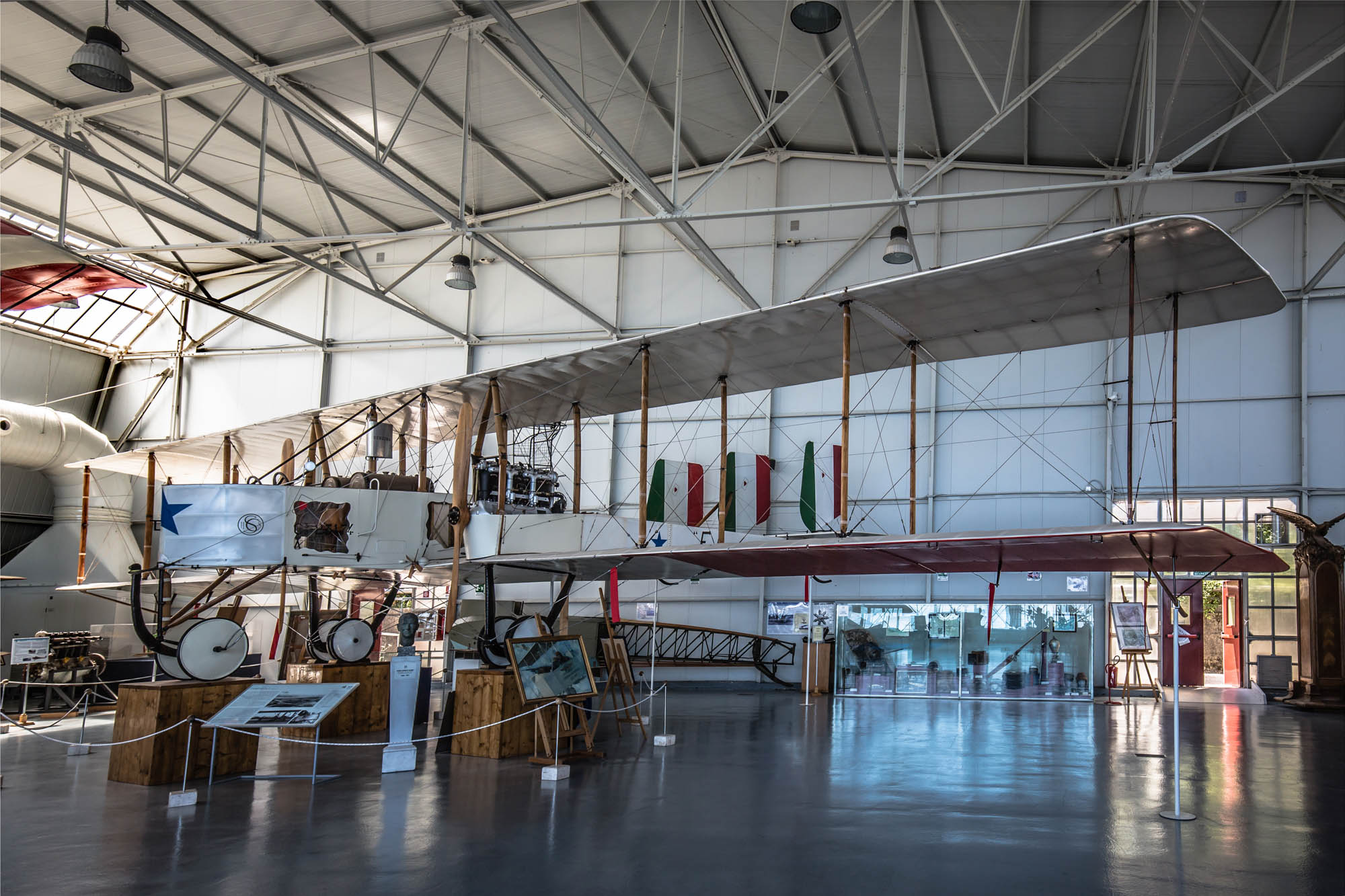 |
The Caproni Ca.3 (23174) for example, is yet another three-engine bomber, unusually having two engines pulling and one pushing. The Ca.3 was derived from the Ca.1 which first flew in 1914 and had three Fiat A10, 100 hp engines. In 1917, 270 Ca.3s were built and delivered with more powerful 150 hp engines. Many bombing raids were carried out by these aircraft during World War One, notably at Assling, Chapavano and at the naval base at Cattaro. Interestingly the example on display was flown in World War One by Lt. Casimiro Buttini, when he got the Gold Medal of Valor. After the War he bought his aircraft for 30,000 lire and stored it in a barn in the Piedmont mountains. It was kept safe till 1959, when it was bought back by the Italian Air Force for the museum.
By March 2008 the example on display had received some additional paint work. |
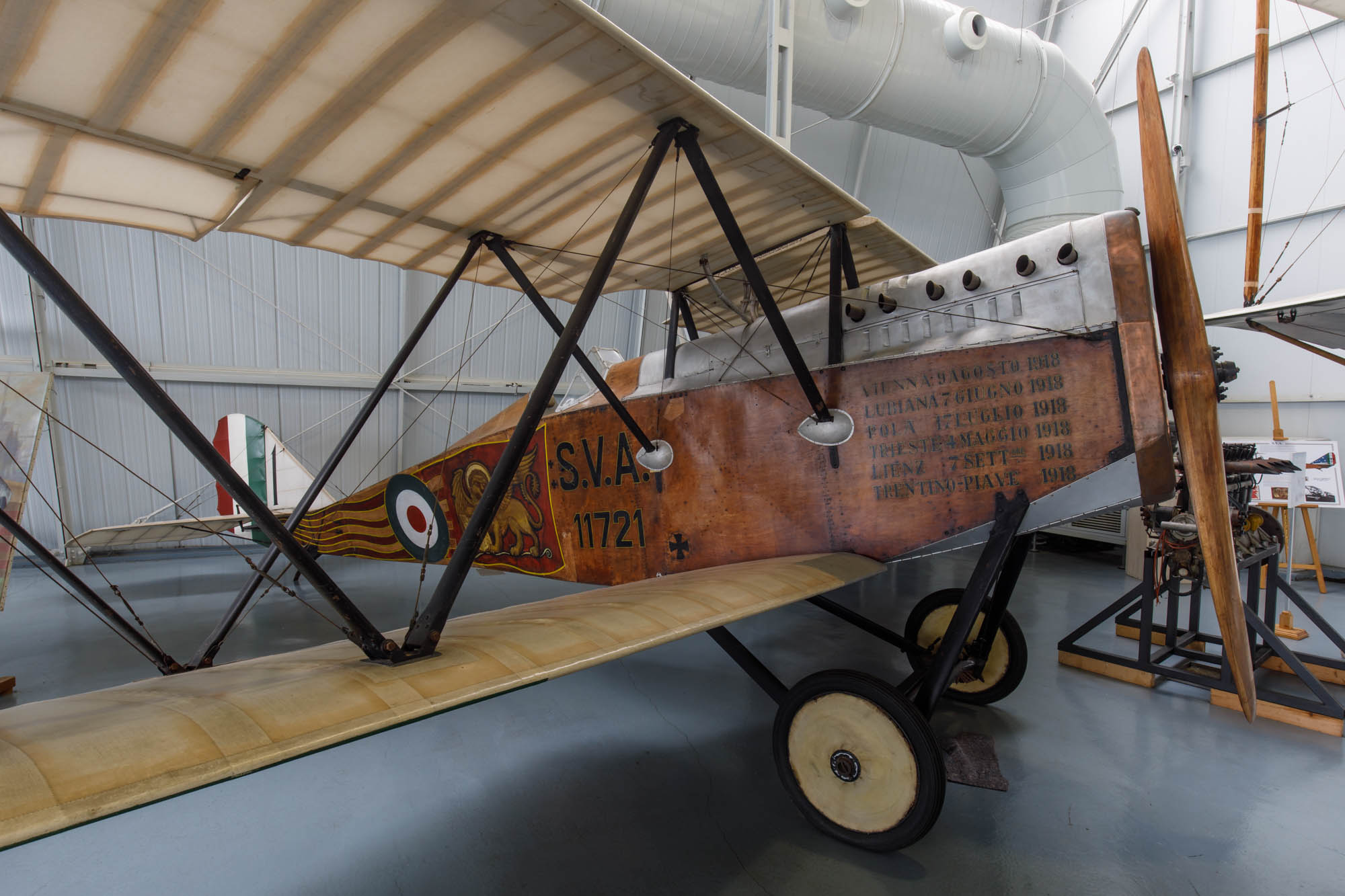 |
| The Ansaldo SVA-5 was designed by Savoia and Verduzio and built by Ansaldo (SVA), with over 2,000 being delivered from 1917. It was Italy's first all Italian aircraft and the fastest of World War One. Used mostly for reconnaissance, its most memorable sortie was made by aircraft from 87th Squadron over Vienna on August 9, 1918, when they dropped leaflets inviting Austria to surrender. It is one of these actual aircraft (11721) which is on display in Hall 1. After the War two SVAs flew an amazing 11,250 miles (18,000 km) to Tokyo. Another SVA flown by Antonio Locatelli, who was awarded the Gold Medal, was the first to fly solo over the Andes. |
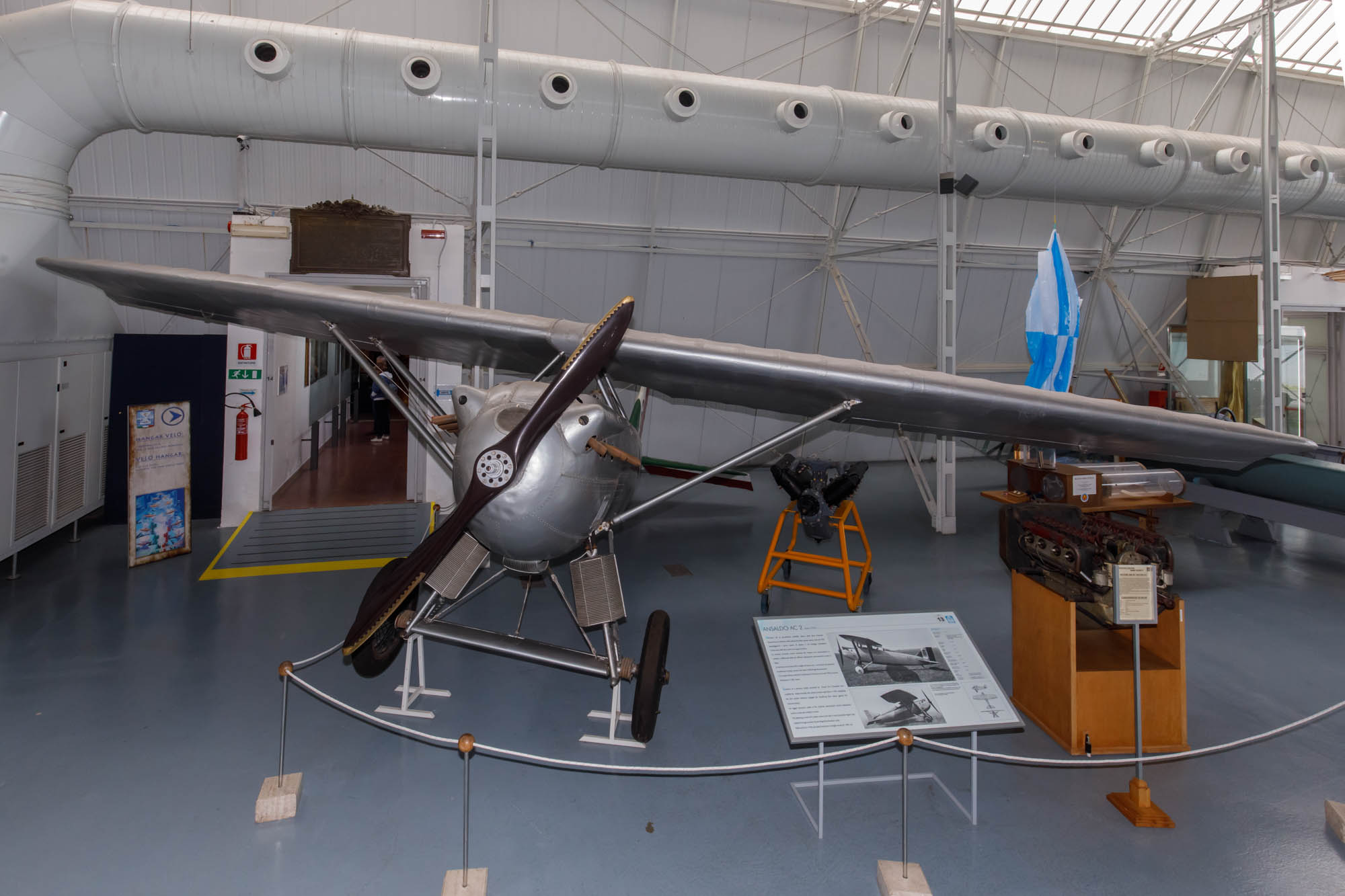 |
| The Ansaldo AC.2 (MM1208 coded '94-6') first flew in 1924 and went into service as a fighter in the following year. It was license-built Dewoitine D.1 which first flew in 1922. A total of 112 were built in Italy. An Ansaldo AC.3, which is a license-built Dewoitine D.9 of which 150 were built, was flown by test pilot Donati to set the world altitude record of 38,914 feet (11,861m) in 1926. As photographed in; 1986 and 2002.
|
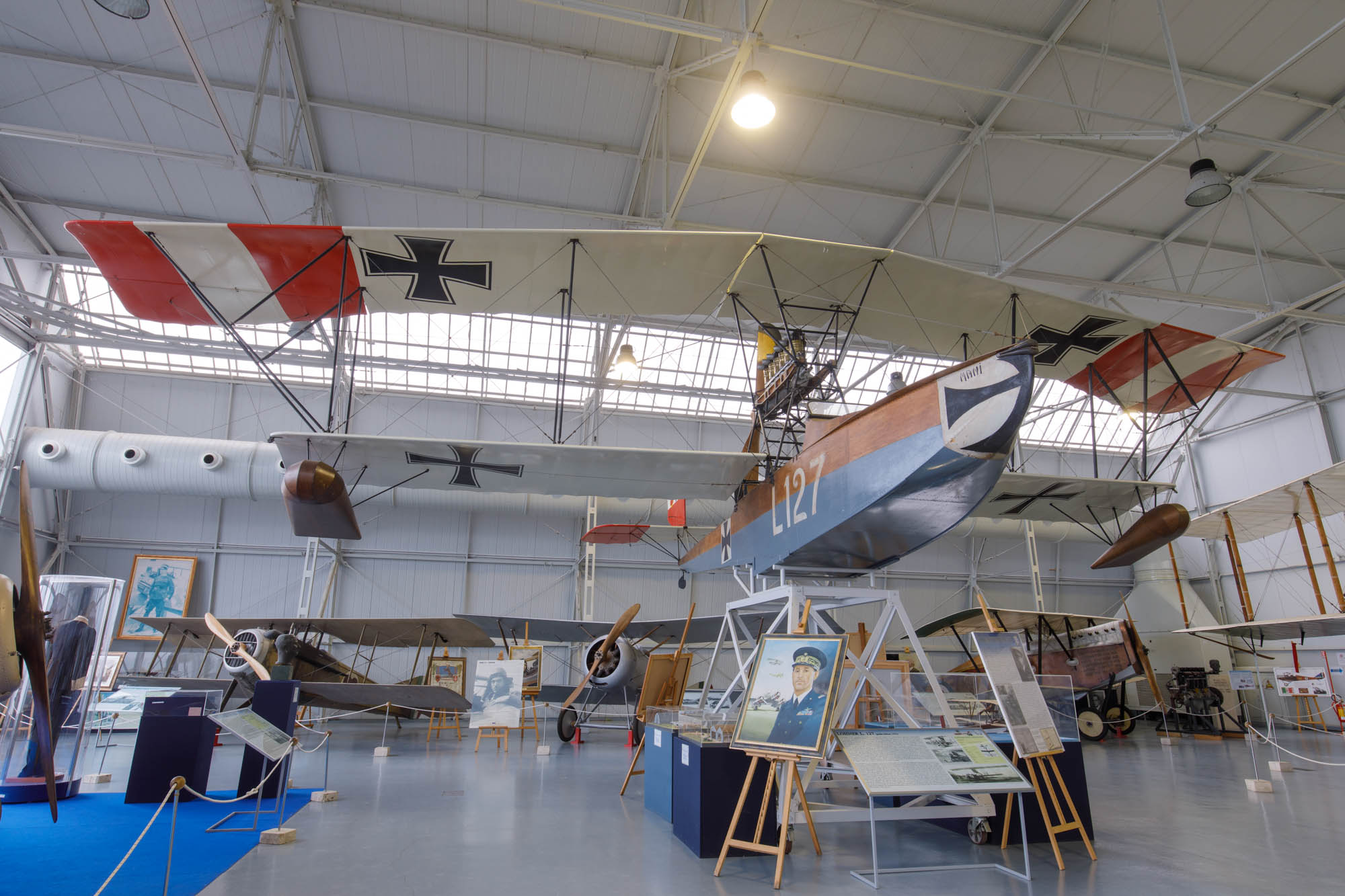 |
| Continuing the seaplane theme is the Lohner L-1, which was designed by Jacob Lohner & Co of Vienna. By 1917 93 had been built and put into service for reconnaissance and bombing. The example on display (L-127) was actually one of 24 built under license by Ungarische Flugzeugwerke A.G of Budapest. It was delivered to the Imperial Royal Navy in June 1916 and took part in bombing raids against Italian positions. On June 3, 1918, while based at Lussino and used for reconnaissance over the Dalmatian coastline, it was taken by two defecting naval pilots of Italian decent, who flew it across the Adriatic to Fano, where it was captured. After considerable restoration this aircraft was transferred to the museum in 1988. |
| Under the power of three engines. |
Remembering back to 1980 the time of my first visit to this museum, my first impression of the Museo Storico was of wonderful aircraft with three engines of which I knew very little.
The Savoia-Marchetti SM.79 Sparviero (1936), the CRDA Cant Z.506S 'Airone' (1936), the Savoia-Marchetti SM.82 'Canguro' (1939) and the Fiat G.212 'Flying Classroom' (1948) these very rare aircraft are now all to be found in the Badoni Hall 3. |
| The Fiat G.212 'Flying Classroom' (MM61804 '142-5'). The Fiat G.212 'Flying Classroom' which entered service in 1948, as a cargo plane, with a range of 1,560 miles (2,500 km). It was designed in early 1940 by Gabrielli as the G.12, at the Fiat factory in Turin. The G.212 on display (MM61804 '142-5') was built in 1949 and was used to train pilots. It was equipped for photo-reconnaissance and could seat 26 to 30. It is the only Fiat produced three engine aircraft in existence. As photographed in; 1988, 1994 and 2002. |
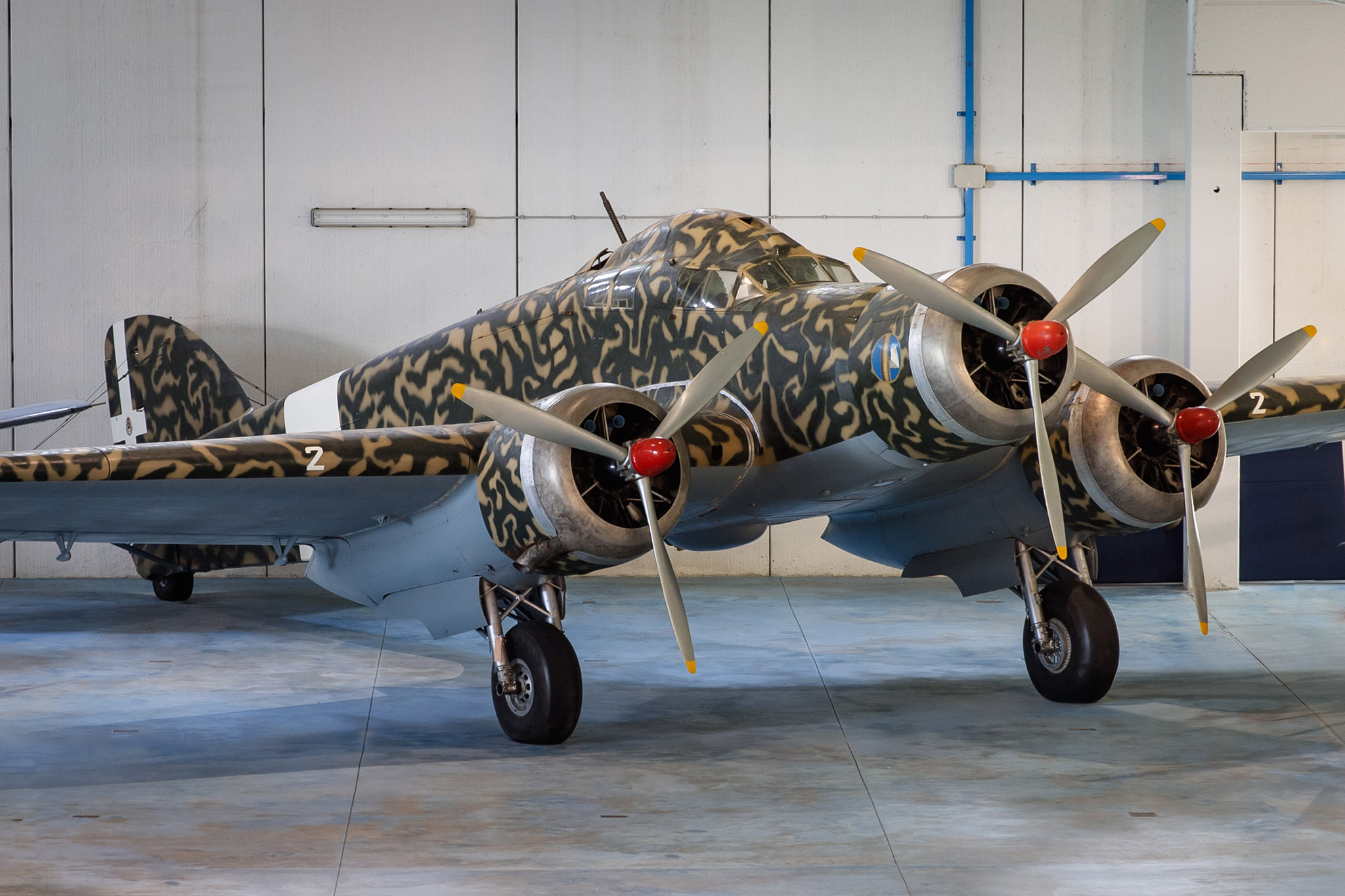 |
Another of the tri-motors is the Savoia-Marchetti SM.79 Sparviero (Sparrow Hawk). The military version was designed to be both a conventional and a torpedo bomber, and entered service with 12° Stormo in 1936. With a crew of six and a range of 2,200 miles (3,500 Km) it flew till the early 1950s as a transport, until its retirement.
The example on display was recovered from the Lebanon, following retirement from the Lebanese Air Force, as L-112. It is restored in an Italian Air Force scheme from 1942 as 'MM24327' coded '278-2', however it is reported as really being MM45508. In 2019 it was showing cracks in the fuselage skin fabric requiring attention. In May 2023 a refurbished patch-up was revealled in an all over dark green colour scheme devoid of other markings. A new fabric skin had been applied over its original skin.
As photographed in; 1990. In 2004 it was to be found in Skema hall, however in August 2006 is was dismantled again for its return to the Badoni hall by March 2008.
The only other complete SM.79 is at the Gianni Caproni Museum of Aeronautics, Trento. |
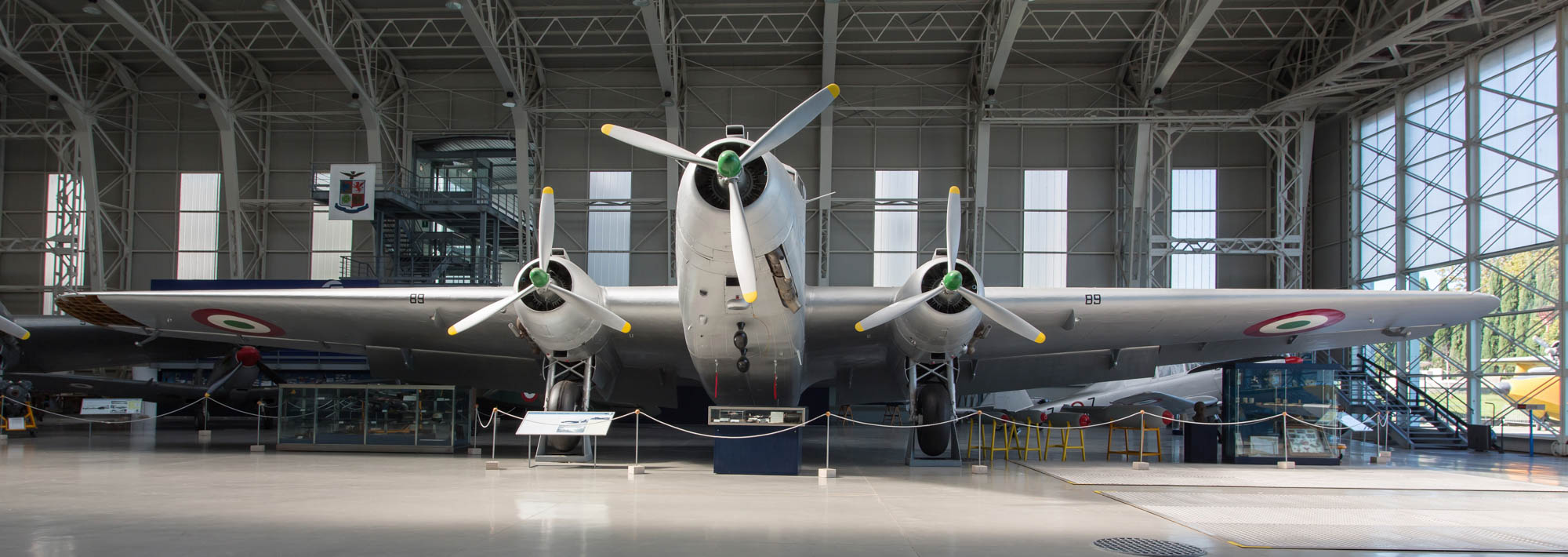 |
| Savoia-Marchetti SM.82 Canguro (MM61187 'ZR-89'). |
Savoia-Marchetti SM.82 Canguro (Kangaroo) also has three engines, it was used as a transport and bomber. Having first flown in 1939 it remained in service till 1960. It was so named as it could carry dismantled fighters in its fuselage. Based on the civil version SM.75 Marsupiale, 875 were built during the war, providing transport between Germany and East Africa. As a bomber, it carried out missions as far a field as Gibraltar and on an oil refinery in the Persian Gulf. It had a range of 1875 miles (3,000 Km). Around 250 survived to the end of the war and were used by the 36th Transport Wing based at Guidonia, till the types eventual withdrawal from service in 1960.
The example on display was painted as 'MM61850' and coded '14' (it is really MM61187) for many years. Some restoration work was carried out from 2004 on the wings in Badoni hall. By August 2006 it was painted as MM61187 and carried the code 'ZR-89' and the restoration was underway with a change of markings applied (it is now coded 'ZR-89') and by March 2008 appeared complete. It now has the markings of the 'Sovereign Order of Malta' on the fuselage, as applied following the Armistice of Cassibile treaty of September 1943 to circumvent the aircraft's destruction. As photographed in; 1996. |
Sea planes, Competitions and World records
There is a wealth of Italian design ingenuity on display, many of the aircraft are rare if not a sole survivor. |
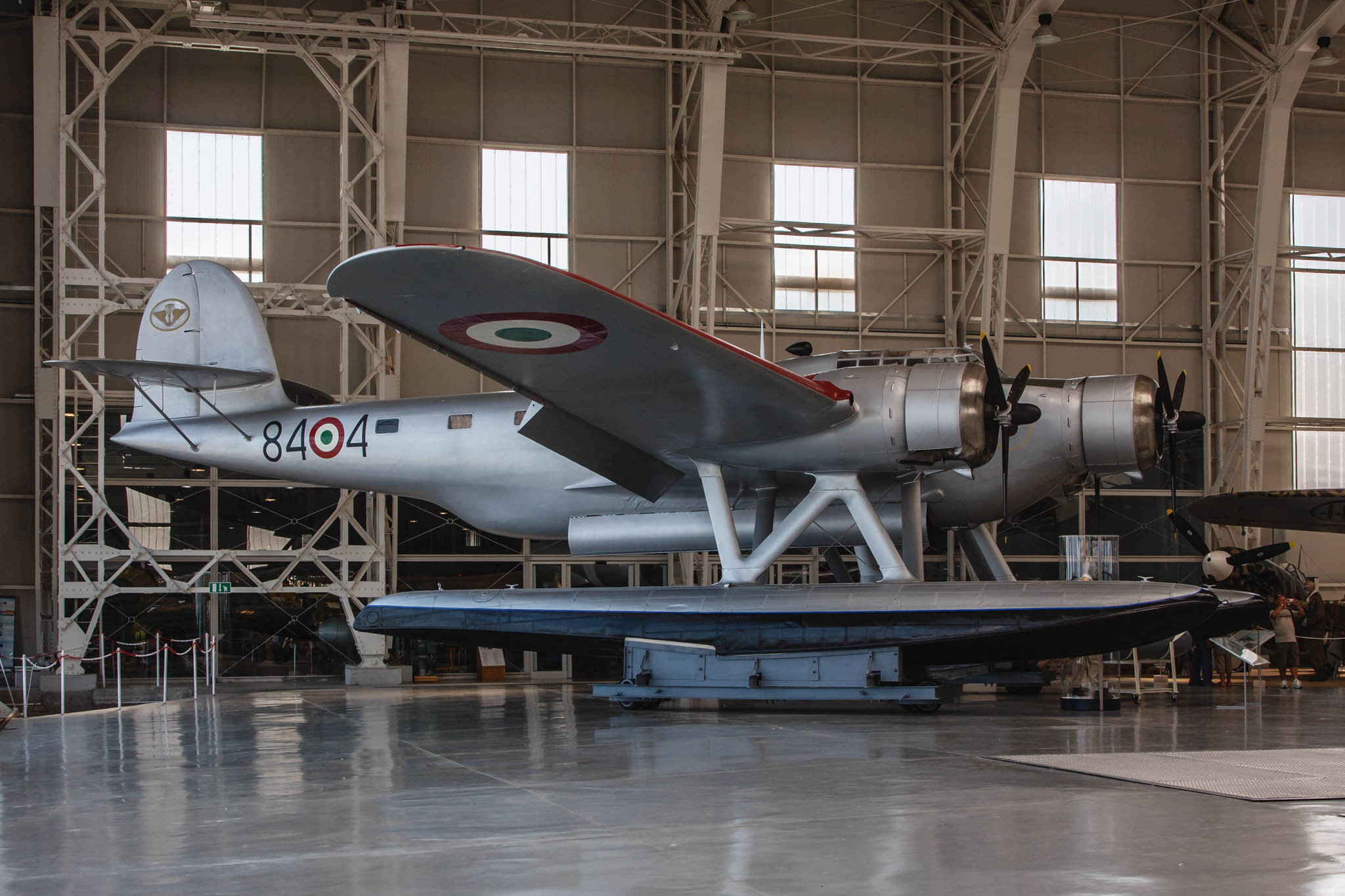 |
| The CRDA Cant Z.506S Airone (MM45425 '84-4') is one of the most impressive aircraft on display. A very large seaplane of wooden construction, it made its first flight in August 1936 and immediately gained eight World speed records and two altitude records for a seaplane. It was originally designed for commercial transport and it could carry 12 passengers. It was later developed as the faster Z.506B to drop bombs and torpedoes. It also participated in the Spanish Civil War and in World War Two. From 1937 to 1943 324 Z.506Bs were built. After the War a few Z.506Bs were converted to Z.506S standard, for its new role as a maritime search and rescue aircraft, with 84º Gruppo based at Vigna di Valle. It had a crew of five and a range of 1,690 miles (2,700 Km). The type was not withdrawn from service until 1960. As photographed in; 1983 and 2002. |
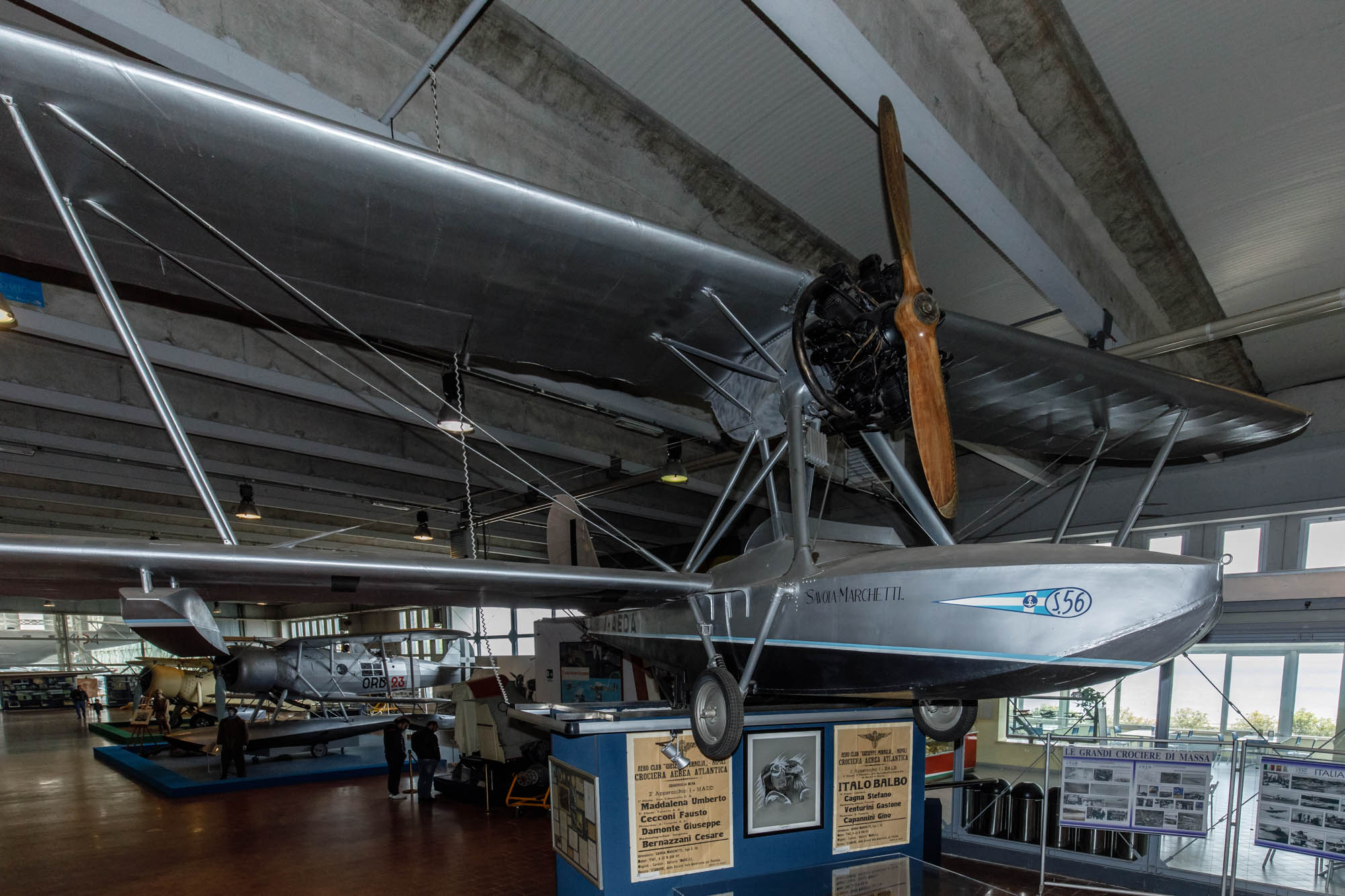 |
| Savoia Marchetti S.56 (I-AEDA c/n 5611). This is one of the first amphibian aircraft, it was designed and built from 1926 by Savoia Marchetti. Additional examples were manufactured in the USA from 1928 by American Aeronautical Corp of Port Washington on Long Island until the early 1930s. Only two examples still exist of the 36 built, the other is on display on Long Island in the United States. By June 2023 it had been removed from display, possibly placed in the new museum store at Piacenza. |
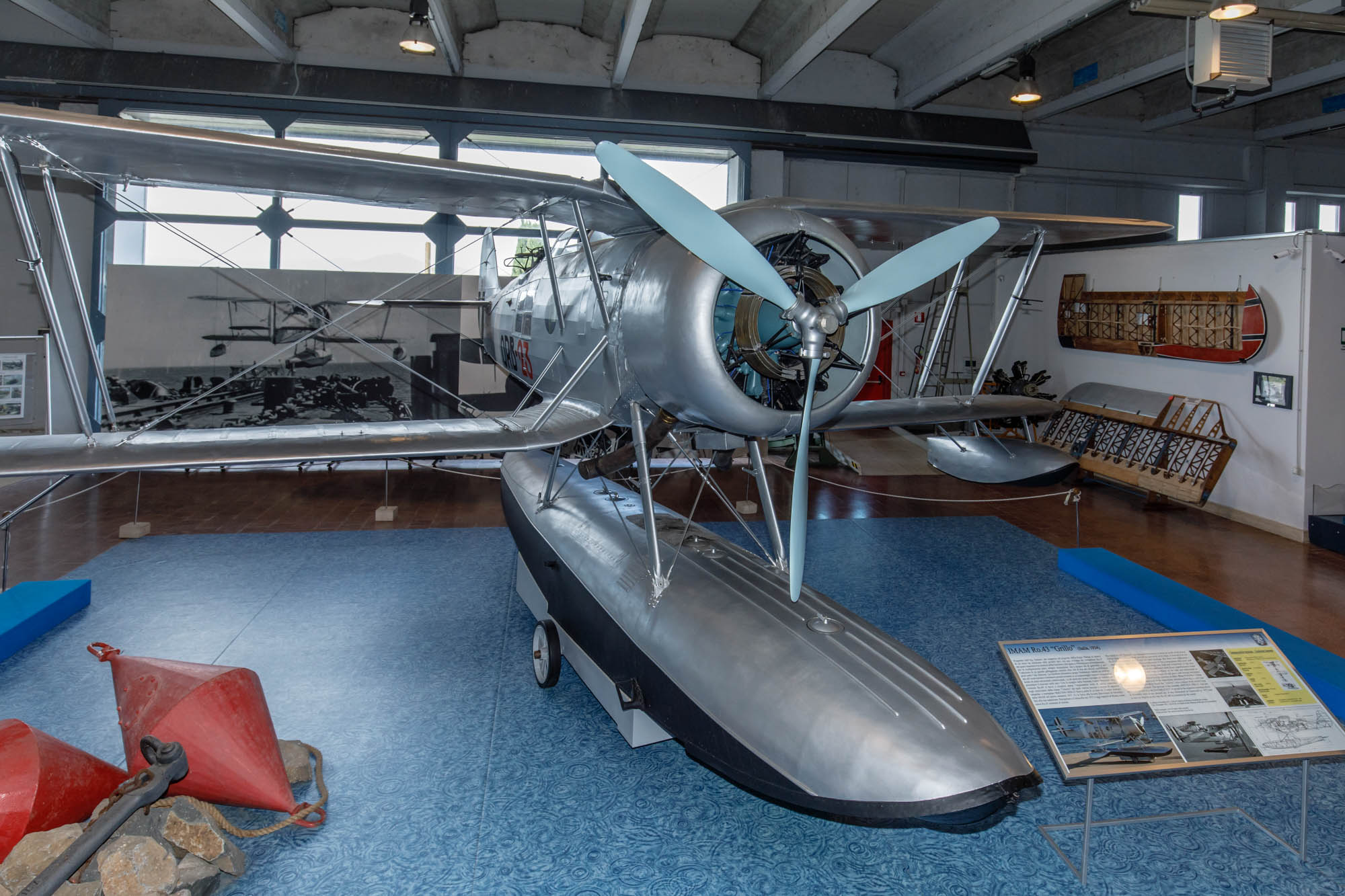 |
IMAM Ro.43 Maggiolino 'Cricket' (MM27050 'ORB-23'). It was built from 1934 to 1941 for the Regia Marina (Italian Navy) as a spotter plane and launched by catapult from their battleships. Although between 200 and 240 were built at the start of World War Two only 105 were in service and by 1943 only 48 were still flying. The design was not very successful it has poor sea handling characteristics and its lightweight construction meant that it was difficult to recover at sea.
The aircraft on display was built in 1937 and is the world's only survivor. It ended its military operations with the Observatory School at Orbetello (ORB). In 1972 it was found at Centocelle, Rome and was refurbished for the Museum where it remained till at least 2000 when it was removed for a further two years of restoration which commenced in 2009 before returning in November 2011. As photographed in; 1983 and 1990. |
 |
| Grumman HU-16A Albatross (MM50-179 '15-5'). They were used for Search and Rescue (SAR) operations by the Italian Air Force (Aeronautica Militare Italiana or AMI) from 1958. The aircraft on display operated with 85º Gruppo of 15º Stormo based at Rome Ciampino. It's last flight was in 1978 to the Museum when it landed on Lake Bracciano. By 2006 following years out in the open its paint had deteriorated, in March 2008 it had been repainted. As photographed in; 1980 and 1993. |
| Fighting in World War Two and Post War |
IMAM Ro.37bis Production of the Ro.37 two-seat biplane for the fighter/reconnaissance role began in 1934. Eventually 160 Ro.37 and 475 Ro.37bis were built a number of which were exported. AMI Ro.37s were all retired from service by the time of the armistice in August 1943.
The Afghan Air Force took delivery of 18 examples in 1938 and amazingly the Italian Army as part of 'ItalFor-12' and part of the ISAF security force in 2006, discovered six Ro.37bis fuselages in a scrap yard on the outskirts of Kabul. It was believed at the time that there no surviving examples of the Ro.37 anywhere in the world. With all the aircraft recovered to Italy it was hoped that two aircraft could be rebuilt and restored to their former glory.
Left to right: IMAM Ro.37bis (MM11341 '110-12') now fully restored having returned to the museum from a short display in Milan. |
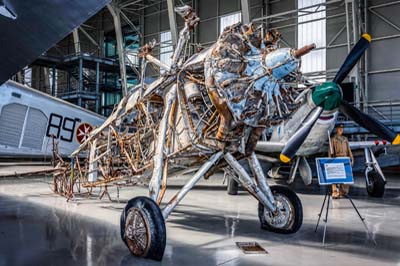 |
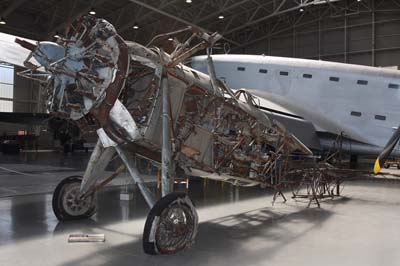 |
| IMAM Ro.37bis The composite and bare fuselage on display in the museum in March 2008 possibly comprises MM11328 and/or MM11322. MM11335 was a another example recovered from Afghanistan. At least two examples from Afghanistan were in store at Guidonia when I visited in December 2010 and the above example was no longer on display at the museum as it had been transferred to Venegono Superiore at Varese for restoration, with help of personnel from the 1° RMV of Cameri and the 10° RMV of Lecce who were working on the engine and the wings. |
IMAM Ro.41. Over 700 of this single-seat biplane fighter were built by Industrie Meccaniche e Aeronautiche Meridionale (IMAM) in Italy. The Ro.41 was flown from 1937 to 1950. This example is going through reconstruction by GAVS in Rome. The engine and most of the frame are original, with a new set of wings are currently being built.
Photographed in August 2006 it had since moved to the Badoni hall by March 2008. |
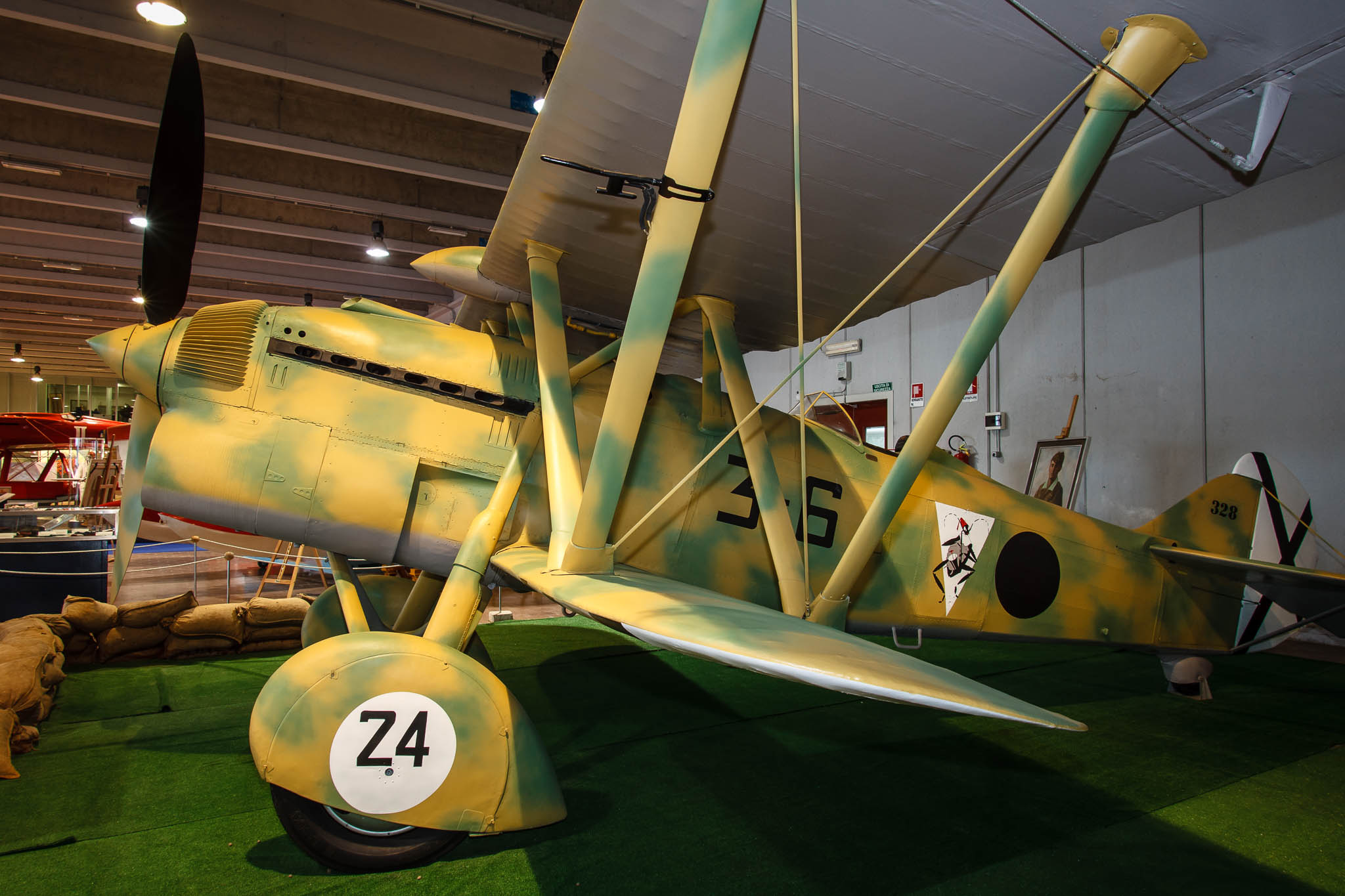 |
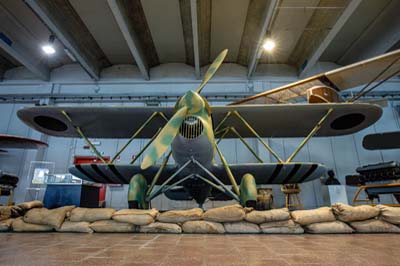 |
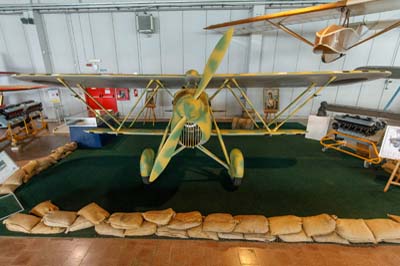 |
| The Fiat CR.32 was developed as a fighter aircraft from the CR.30, first flew in 1933. Its impressive manoeuvrability made it the plane of choice for aerobatics teams in the 1930s. The Spanish imported Italian technology, building the Hispano HA 132L which was based on the Fiat CR.32. The example on display was donated by the Spanish Air Force in 1955, has been recently painted in Spanish civil wars colours, as C.1-328 '3-6'. It was previously painted as MM4666 'VIII-92', prior to restoration by GAVS of Turin using 40% of its original parts. It is one of only two examples still in existence, of the 1000 aircraft built and exported around the World to such countries as, Austria, China, Hungary, Paraguay, Spain and Venezuela. |
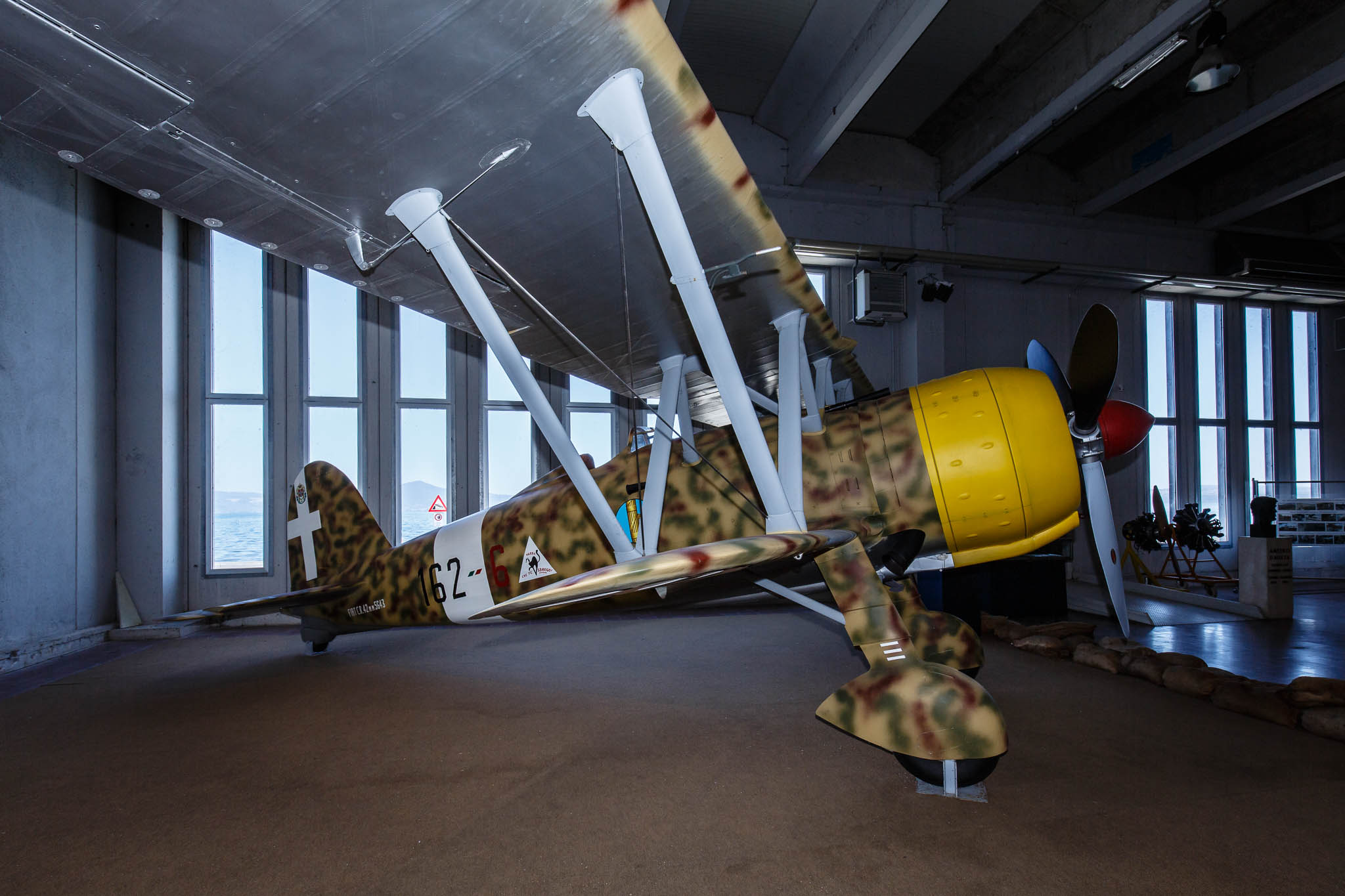 |
The Fiat CR.42 Falco (Swedish Air Force Fv 2539 registered SE-AOP painted as 'MM5643/162-6') on display is the product of an eleven year restoration using parts from a number of aircraft recovered in Sweden and France. Restored by the Associazione Restauro Aeronautico (AReA) of Venegono it was put on display in May, 2005. It is painted in the colours of 162 Squadron as flown by Sandro Ferracuti when based on Rhodes in 1940-41. The Italian Air Force originally ordered 200 examples as primary fighters. They were later used as night fighters and trainers. The CR.42 was also flown by the Belgian (30), Hungarian (72) and Swedish (72) air forces. It was superseded by the MC.200 in the Italian Air Force.
Only four CR.42s exist today; see also Linköping, TFC Duxford and at RAFM Hendon.
|
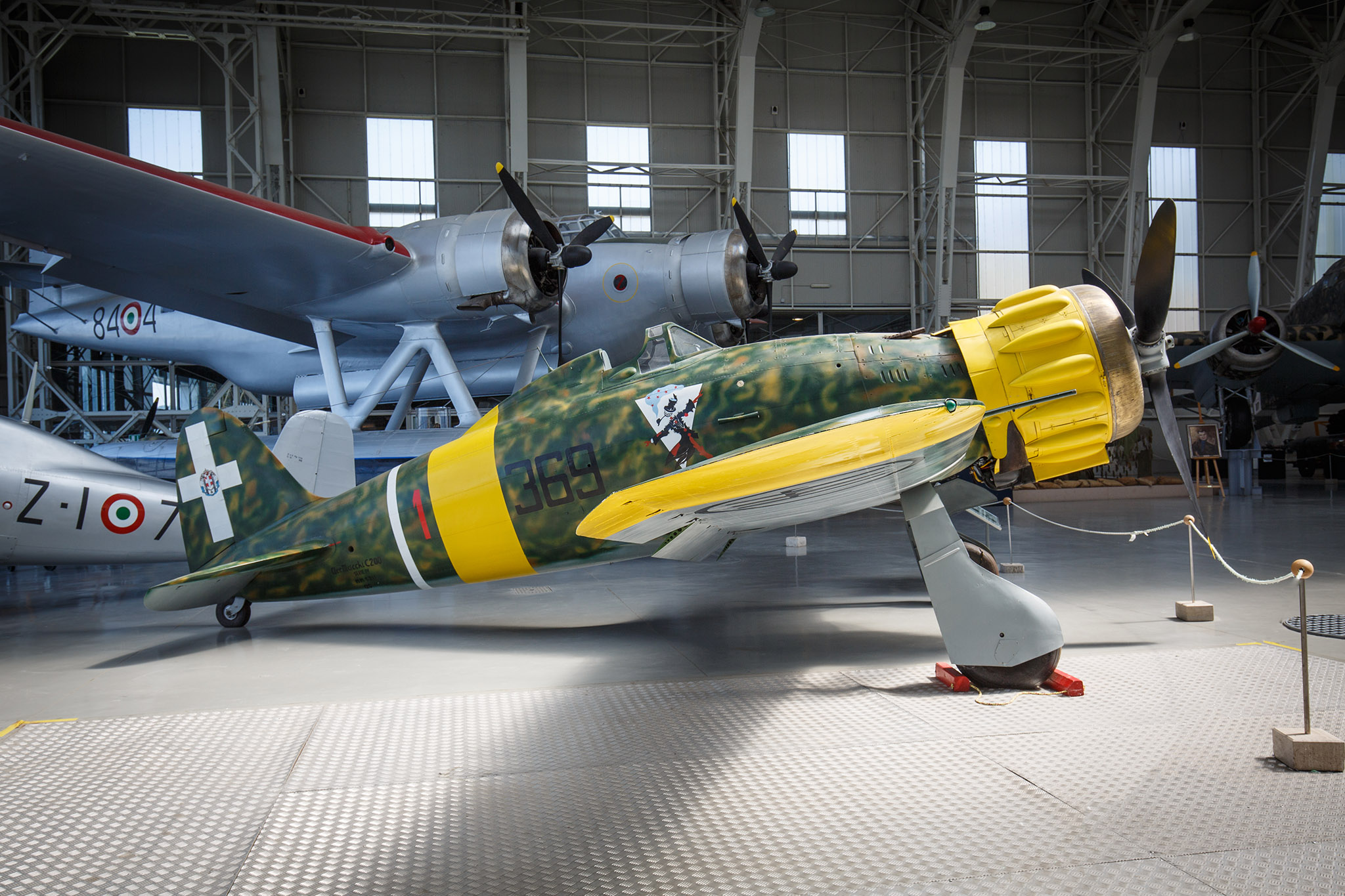 |
Aer Macchi are well represented with ten aircraft on display, including the MC.200 Saetta and later derivatives, the MC.202 Folgore and MC.205 Veltro. These were used as fighters during World War Two.
The Macchi Castoldi MC.200 Saetta (MM5311 coded '369-1' is on display) employing a radial engine, was built in large numbers, but initially suffered from a poor wing design which was later modified to improve its aerodynamics. In service the Saetta was fast with excellent maneuverability, and good to handle. During World War Two, it was eployed in Greece, North Africa, Yugoslavia, and the Mediterranean. It became the Italian aircraft with the most operational sorties of the war. |
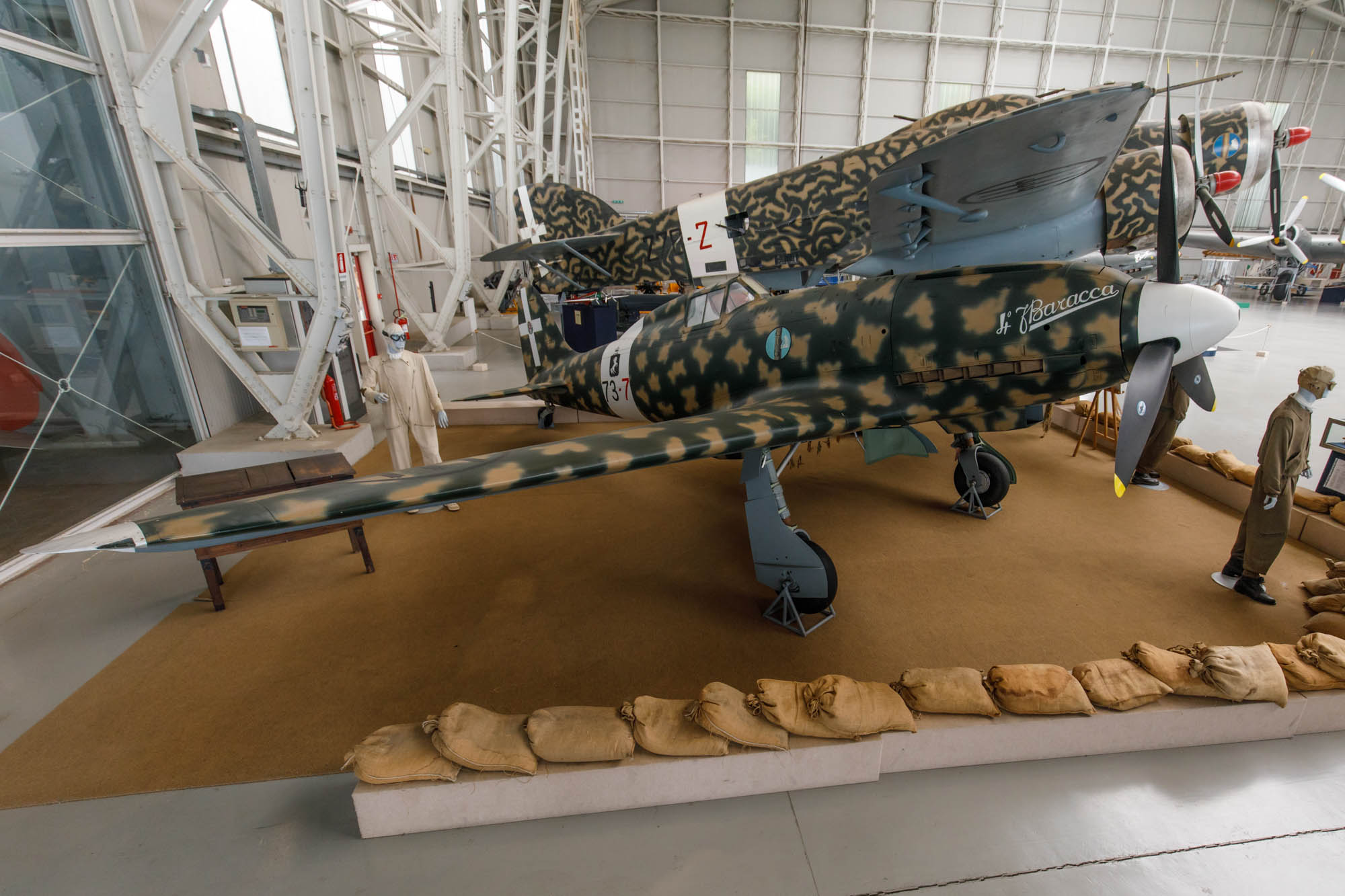 |
The Macchi Castoldi MC.202T-AS Folgore (MM9667 coded '73-7') The Macchi Castoldi MC.202 was developed from the MC.200 and was capable of 375 mph (600 Km/h). It also had two 12.7mm guns and flew in Russia and Africa.
The example exhibited, until the mid 1990s, was painted as 'MM7844' coded '91-3' in 1986 and in 1993. It is one of only two that remain, the other is at the National Air and Space Museum in Washington, USA.
The MC.202 Folgore and MC.205 Veltro adopted a new and improved wing design with superior Daimler-Benz engines. It was flown in support of operations on the Russian front from 1941-42 and also in Africa. It was armed with two 12.7mm guns and could carry two light bombs. After the War they were used as trainers until their withdrawal from service in 1947. |
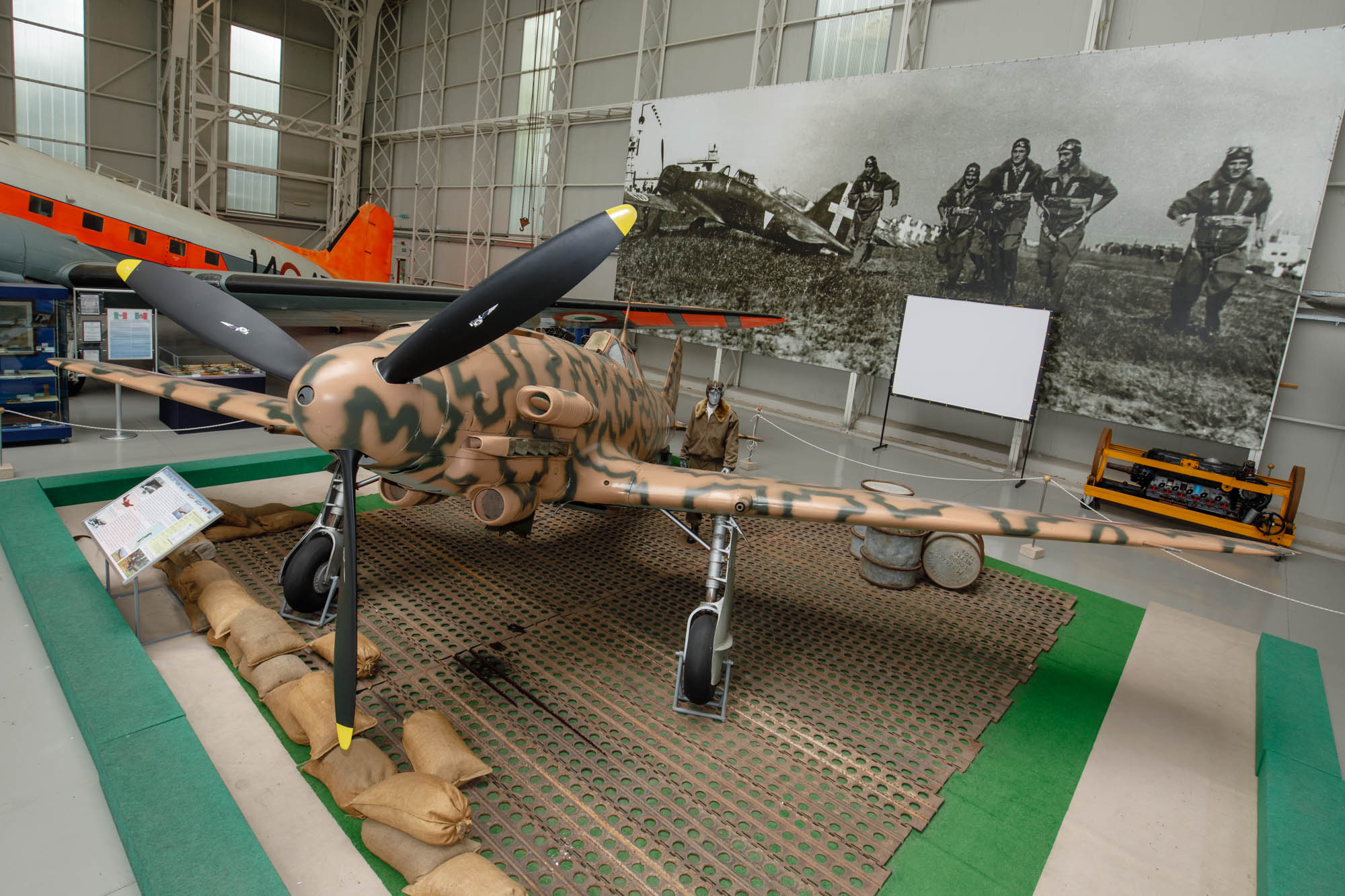 |
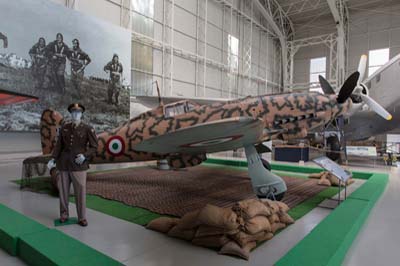 |
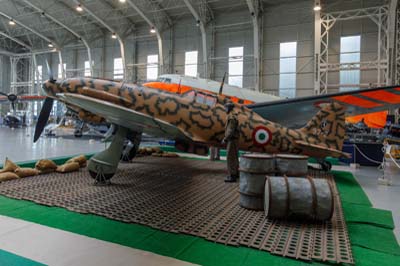 |
| Also on display is a Macchi Castoldi MC.205V Veltro (MM9546 coded '97-2' it was also painted as MM9345 '155-6' previously). The MC.205 of which 262 were built, were developed from the MC.202 first flew in 1942. The aircraft on display was converted from a MC.202 and was built at Breda in 1942. When photographed in 1996. |
Another famous Italian fighter represented, is the Fiat G.55 Centauro which was designed by Gabrielli as a single seat fighter and produced in the Fiat factory in Turin from 1942. They were in operation by the Italian Air Force, till the armistice of September 8, 1943. After that date they were flown against the allies by the National Republic Air Force (ANR) until they were all completely destroyed.
As no G.55s survived the War, the aircraft exhibited is based on a modified Fiat G.59 (MM53265), following recovery in the 1980s from a Park of Remembrance in Novara. Restoration was started by GAVS of Turin in 1995 and was later transferred to 3º RTA (10º RMV) at Lecce. The restoration was completed in 2002. It is painted as '5' of the A.N.R of the 'Montefusco-Bonet' Squadron. |
| Fiat G-59-4B (MM53276) back on display and looking good in September 2016 after its restoration. |
Fiat G-59-4B (MM53276). The G.59 was developed from the G.55 and produced from 1950 onwards, it was the last piston engine fighter to be produced in the world. A single-seat and two-seat version was built, they served with the fighter school until 1965.
It arrived from the Museum of Flight in Turin in the 1970s when the museum moved south. In 2013 it was decided that this aircraft be restored in the restoration/maintenance hangar on-site. Under the paint it was discovered that it had previously been coded 'R-B+36' and later 'RM-41', however from archives an earlier code of 'SE-7' from 1957 was found for this aircraft and it was this that was applied after restoration when it was painted in a metalic sky blue scheme. It was put back on display in November 2015. As photographed in; 1983 and 1996. |
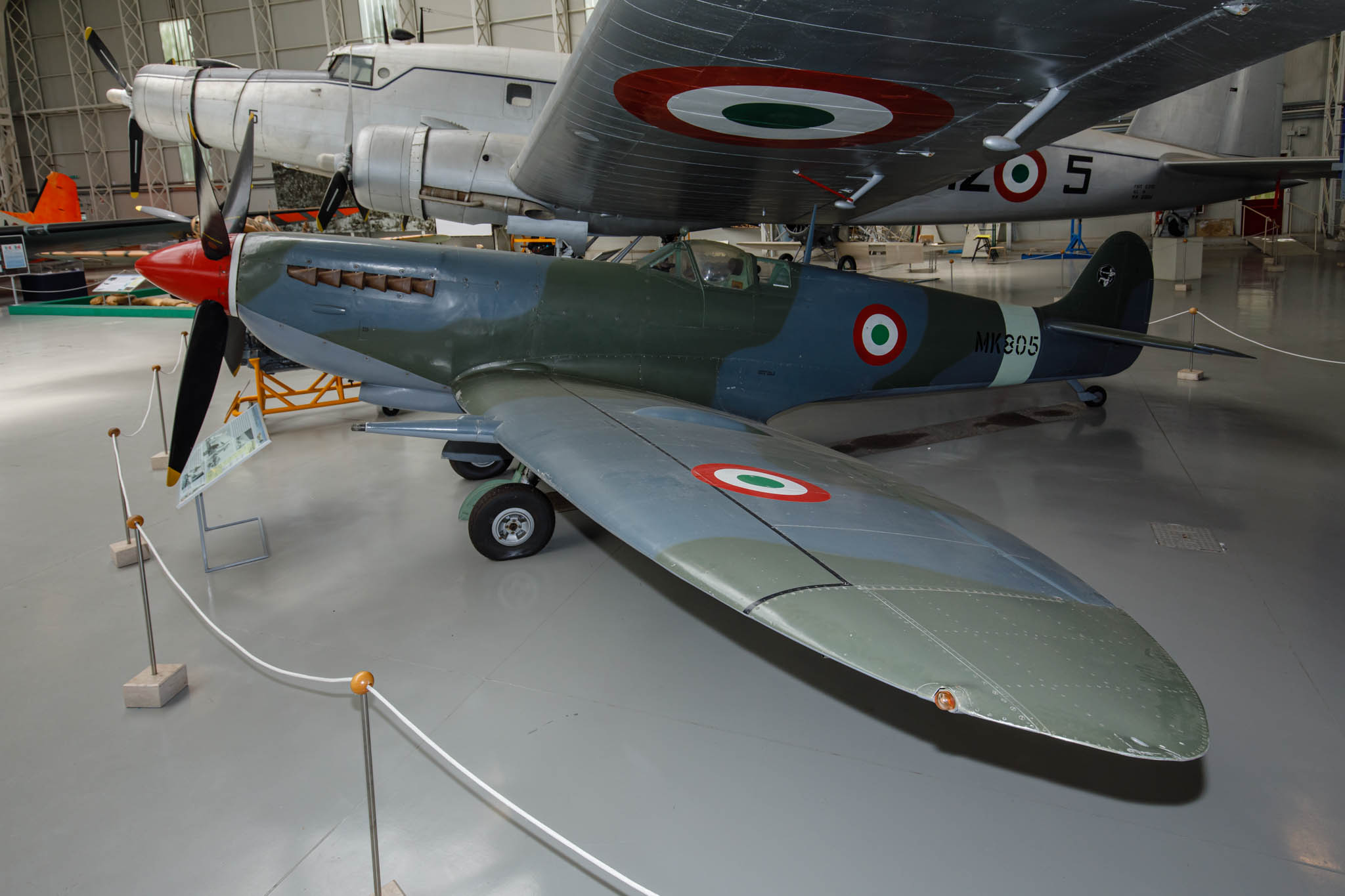 |
| From 1944, Supermarine Spitfire Mk.5s and Mk.9s flew with the 20º Gruppo, 51º Stormo of the AMI. Later in 1946 additional Mk.9s were flown by the 5º and 51º Stormo. The Spitfire on display (painted as RAF MK805, it was previously MM4084) is a Mk.9 and was restored by GAVS in 1989. It had flown with a Polish squadron during the D-Day landings. Later handed over to the AMI it flew from Bergamo with 8º Gruppo of 5º Stormo before being withdrawn from service in 1950. |
| Mustang on display (MM4323 coded 'RR-11') back on display and looking imaculate in September 2016 after its recent restoration. |
To replace the ageing Spitfires, the North American P-51D Mustang entered service with the AMI in 1948. After World War Two, the Italian Air Force (Regia Aeronautica) was devastated and had to be completely rebuilt. The 1947 Paris Peace Treaty imposed strict military limits, but Italy's 1949 entry into NATO encouraged modernisation. Through the U.S. Mutual Defense Assistance Program, Italy received American aircraft, including the P-47 Thunderbolt, P-38 Lightning, and P-51 Mustang to restore its air power.
The Mustang on display (MM4323 coded 'RR-11') carries the personal insignia of General Ranieri Cupini who piloted it till 1953. By July 2012 it had been removed from display for restoration on-site and returned in a polished natural metal state in 2015.
As photographed in; 1983 and 1990.
Photographed in 2006 and by 2008 you can see the additional code '89-ZR' has been applied to the SM.82 in the background. |

